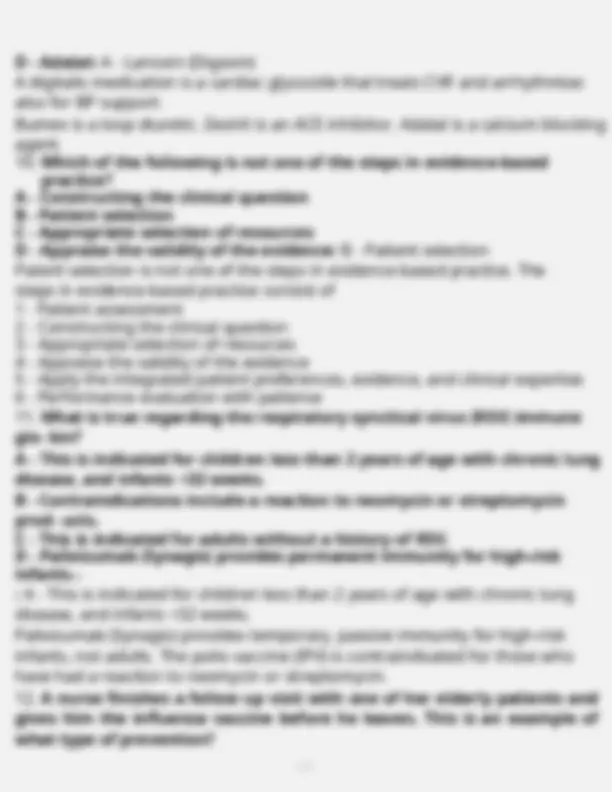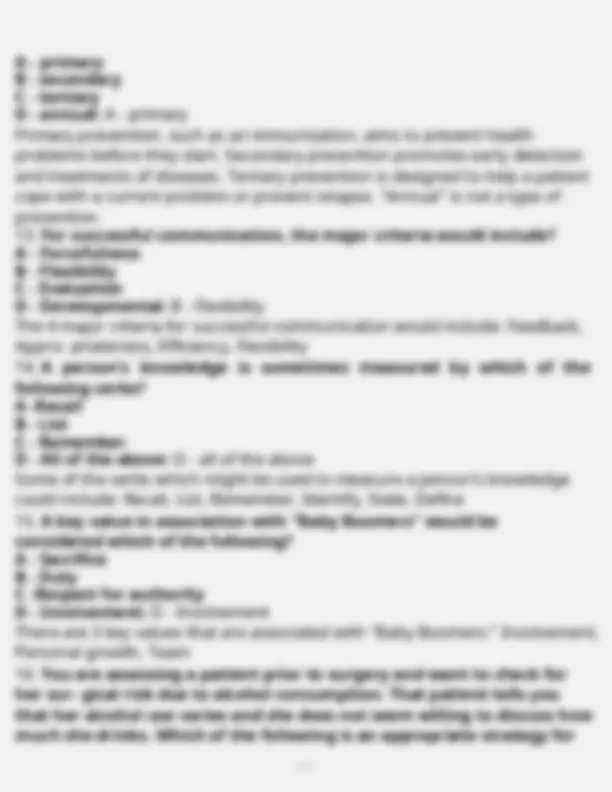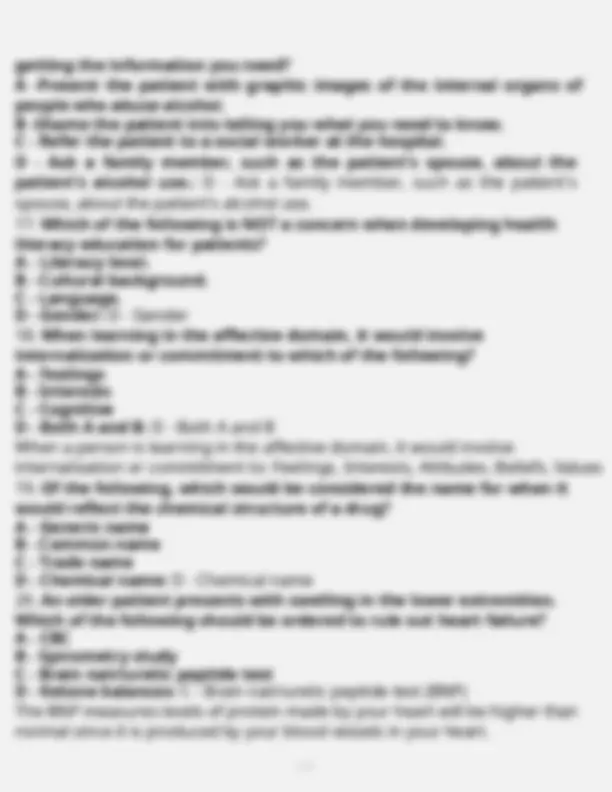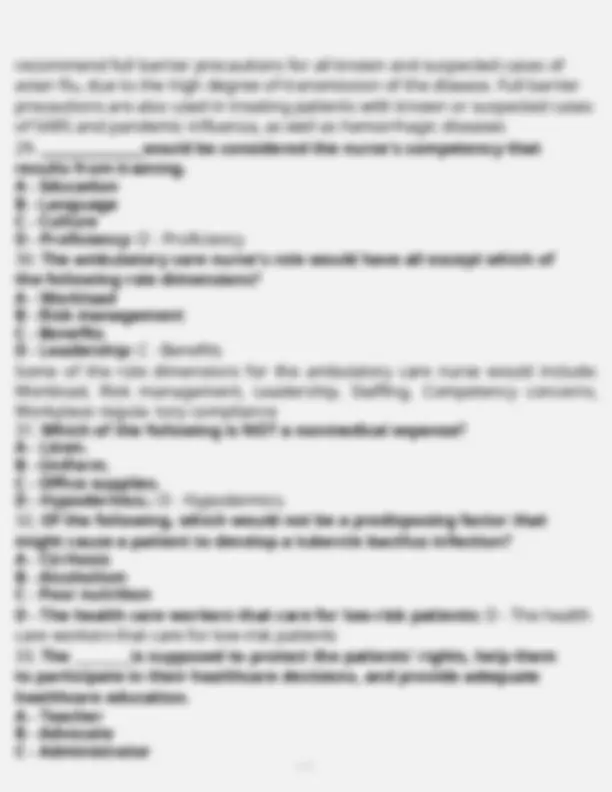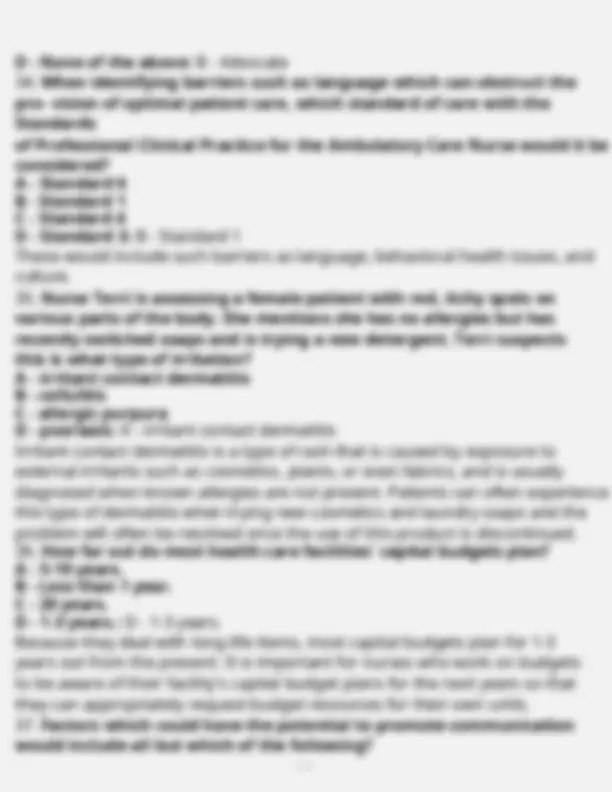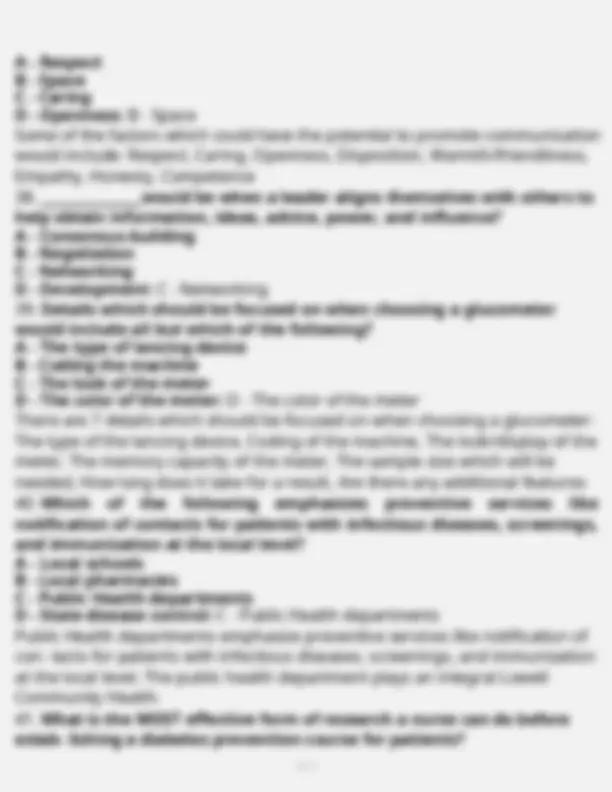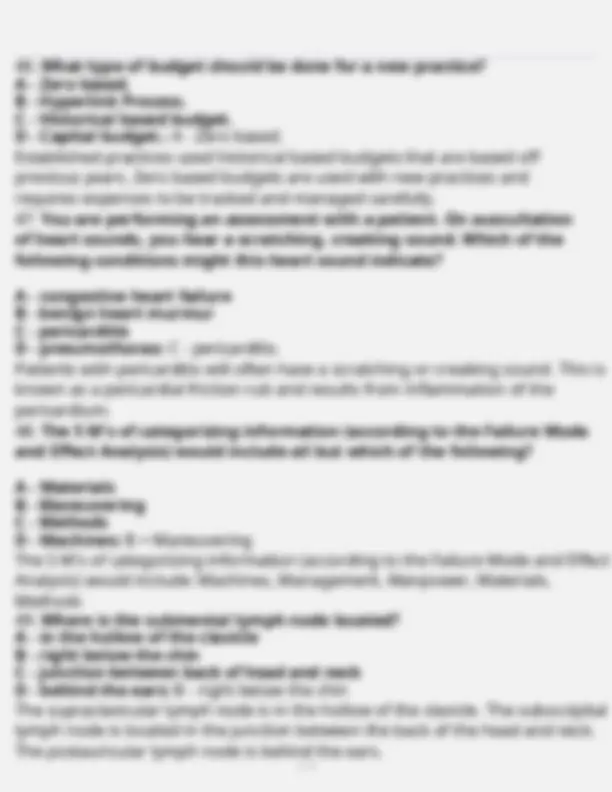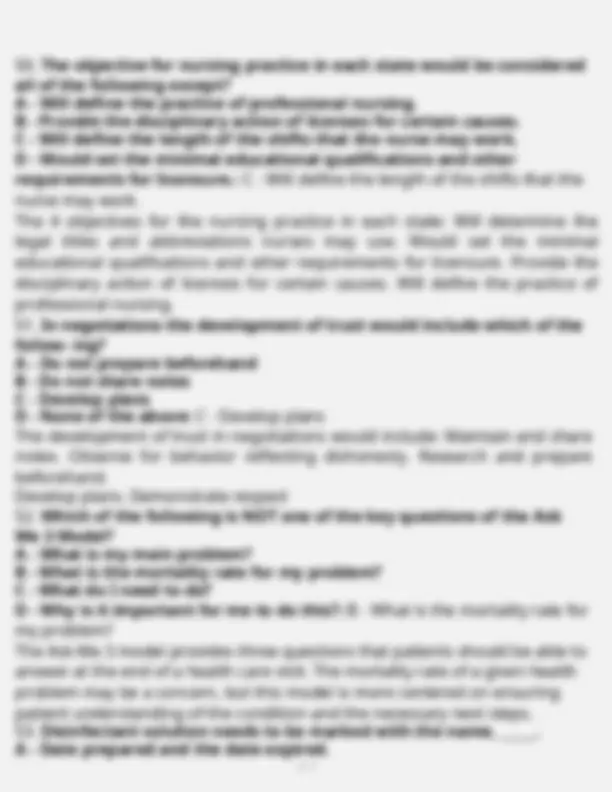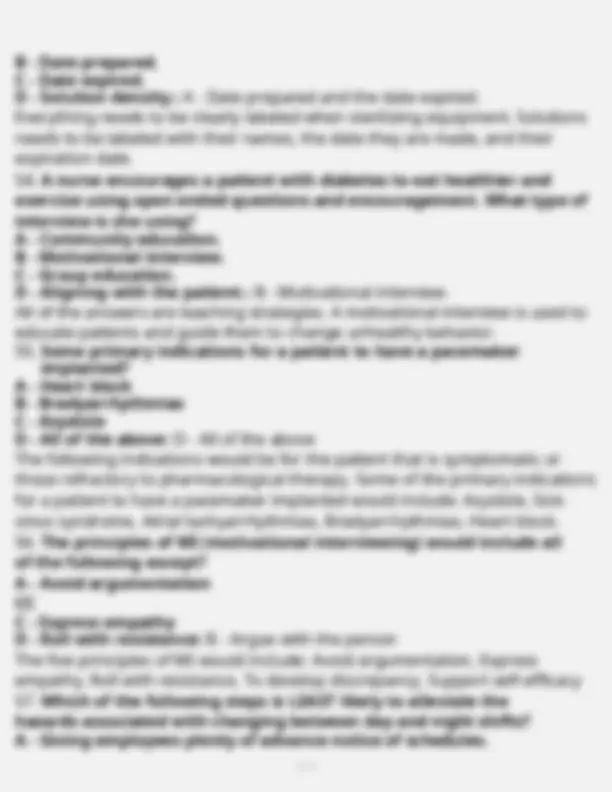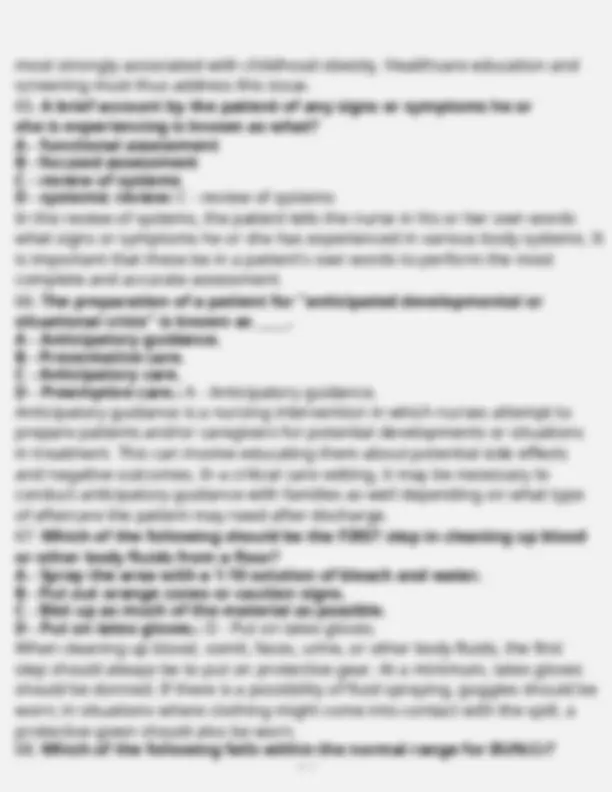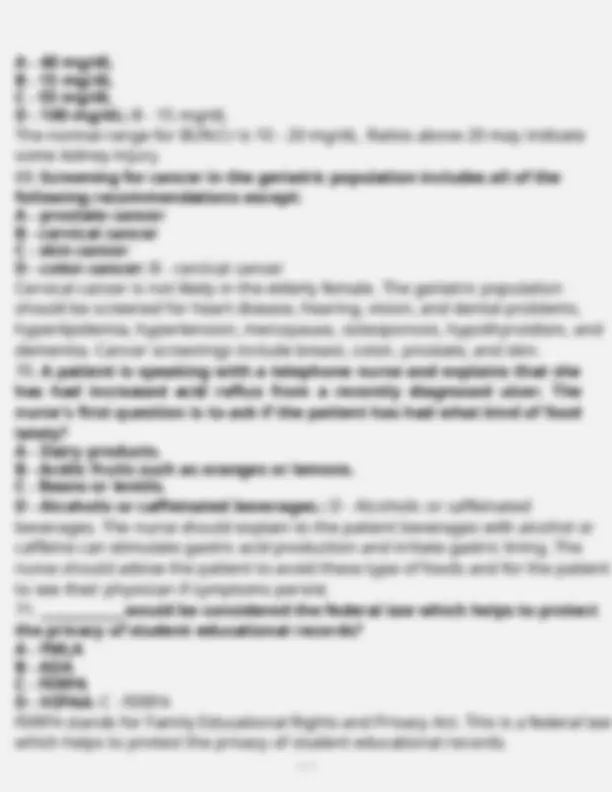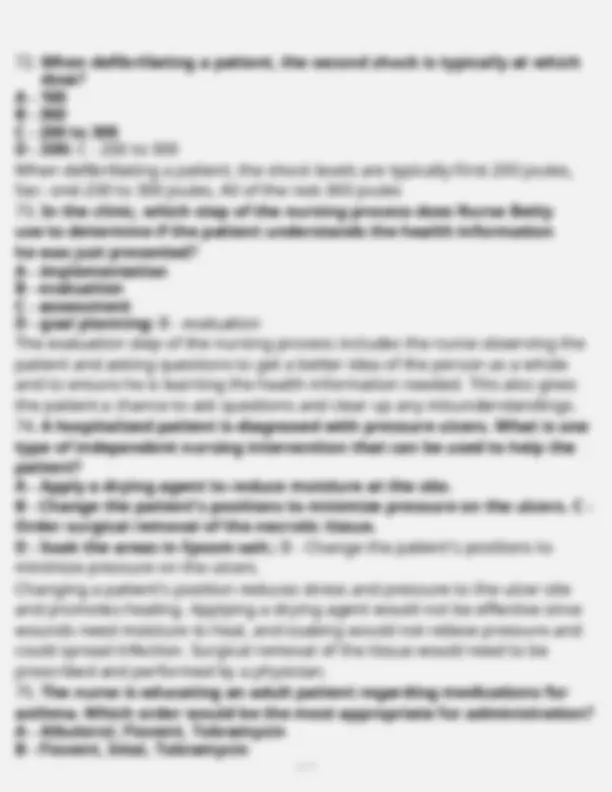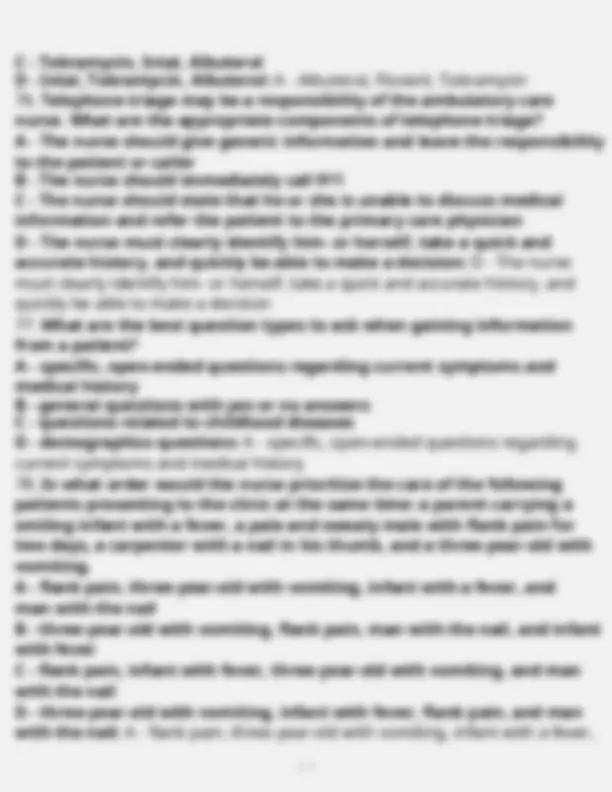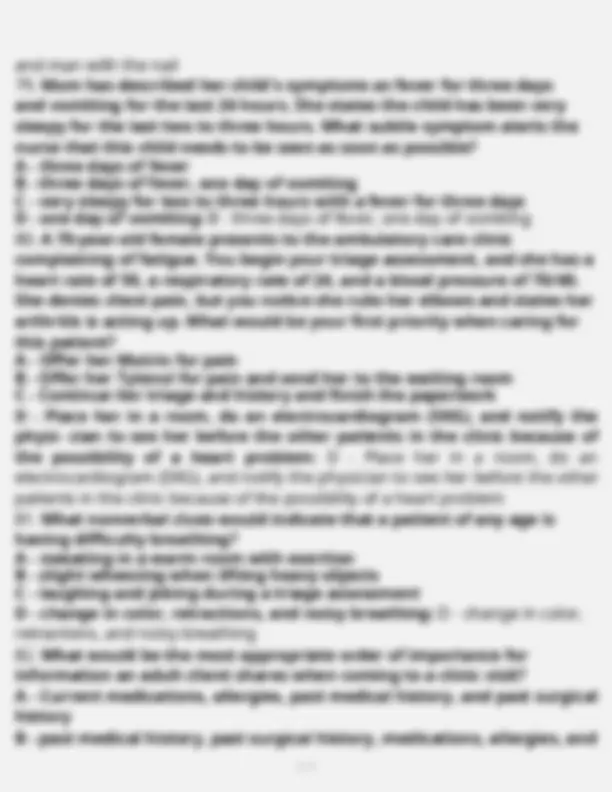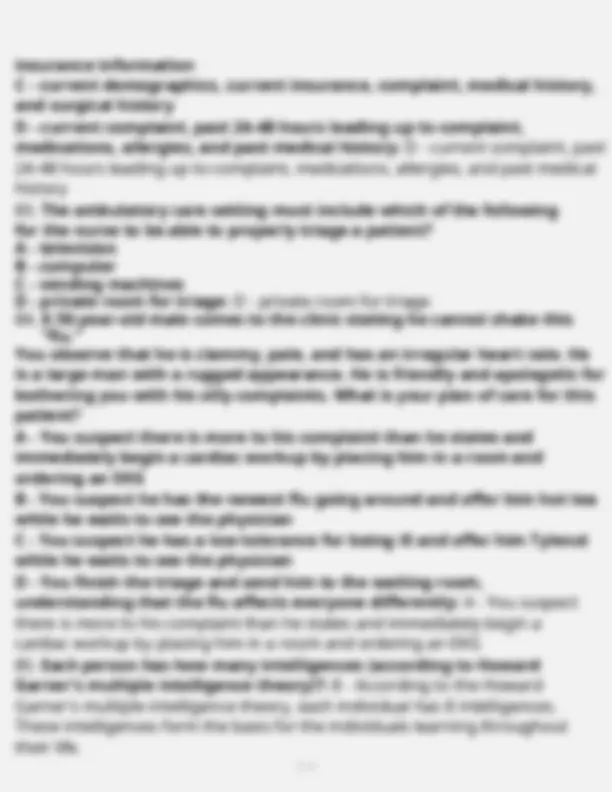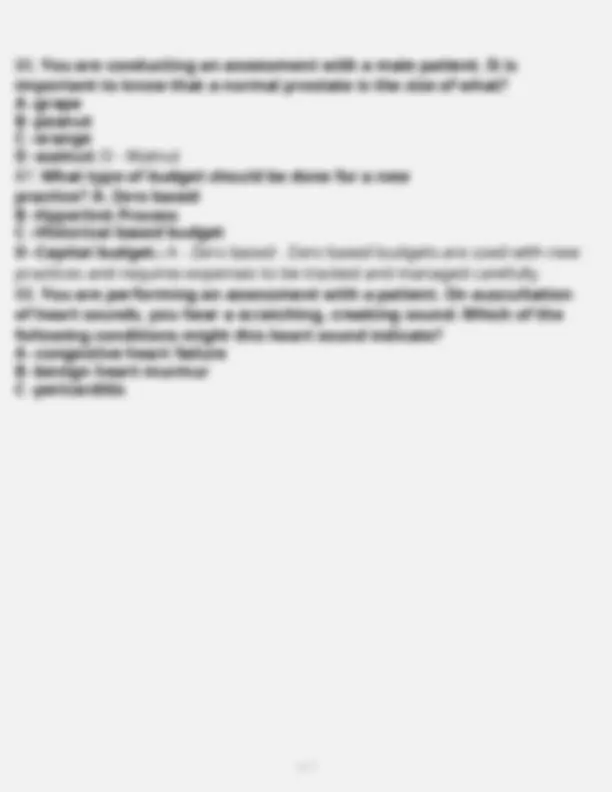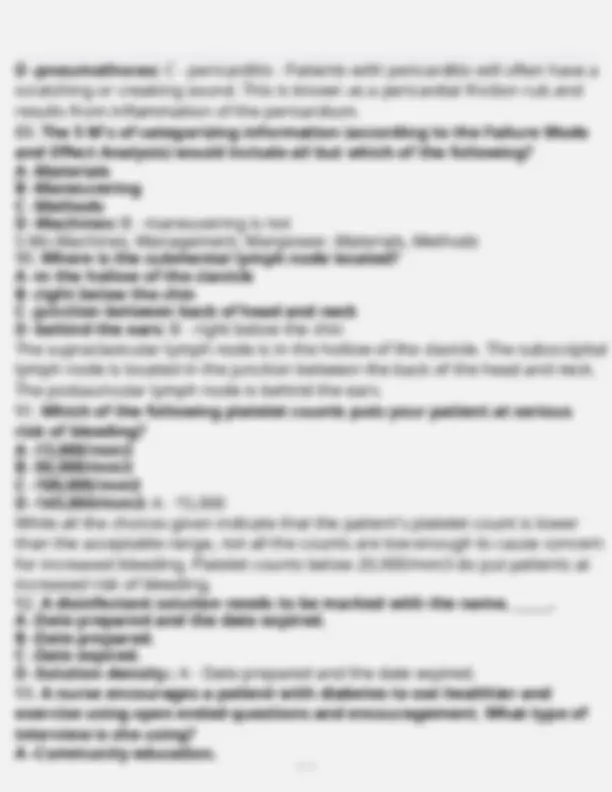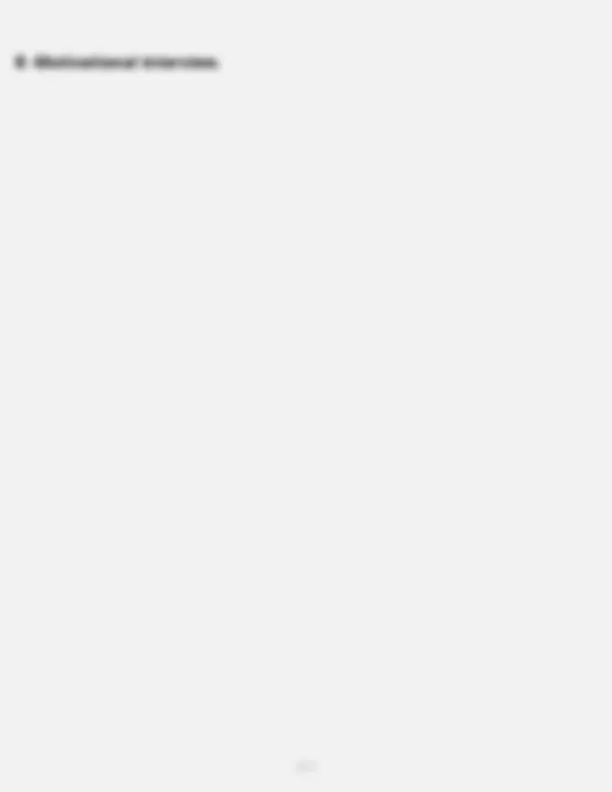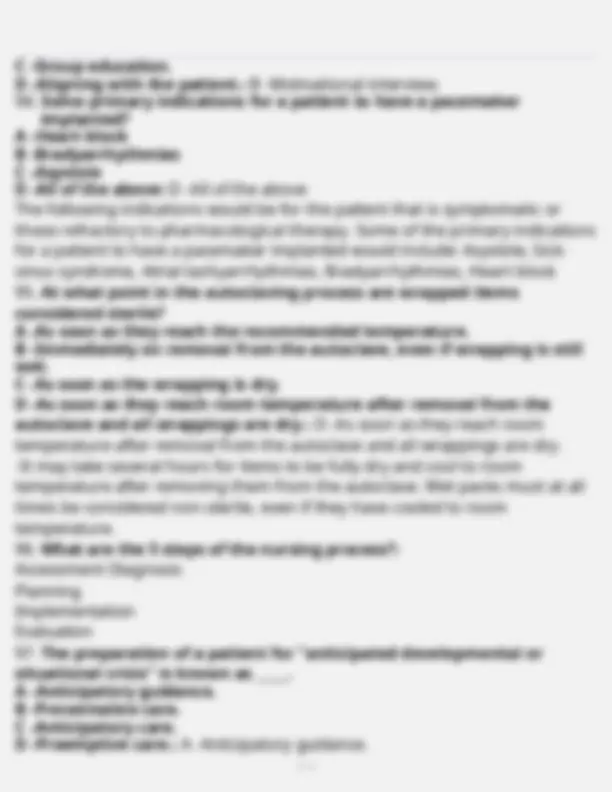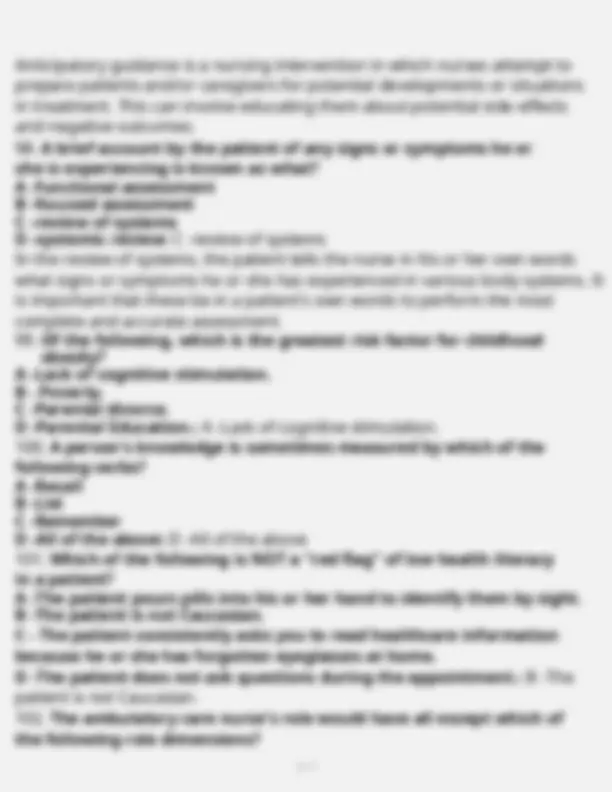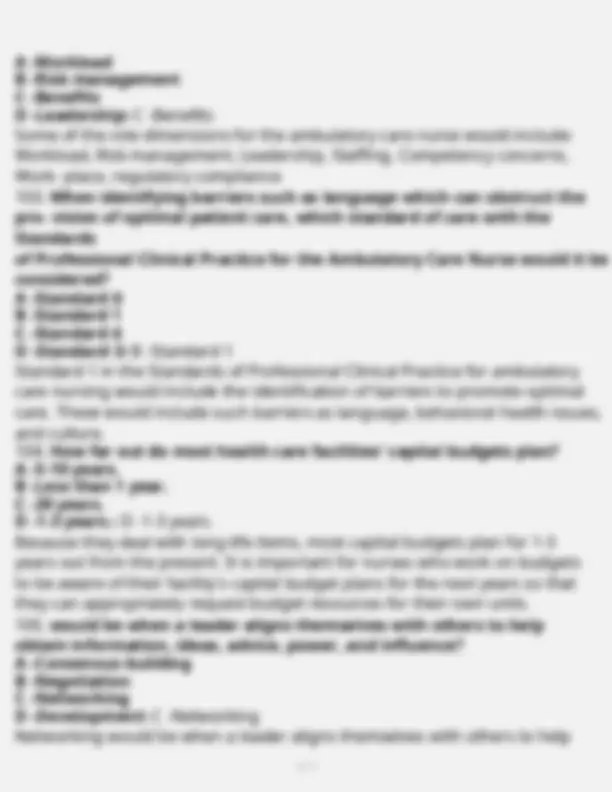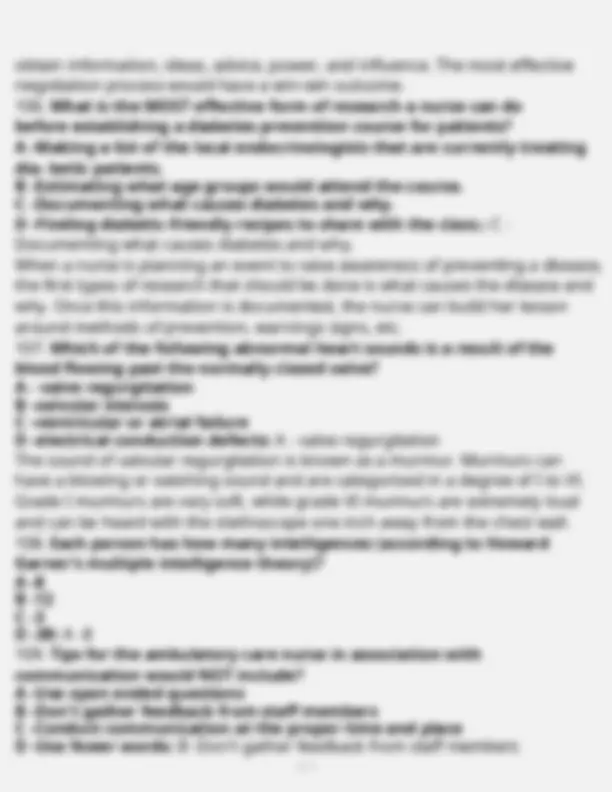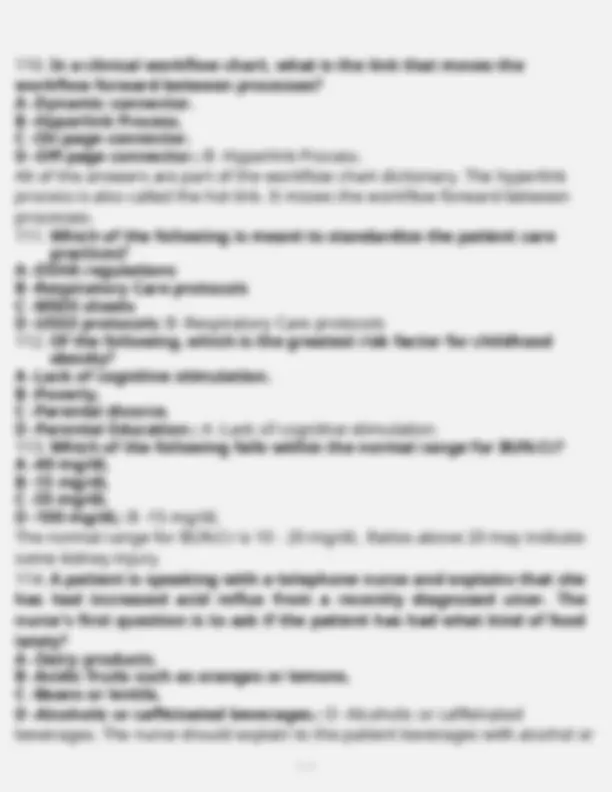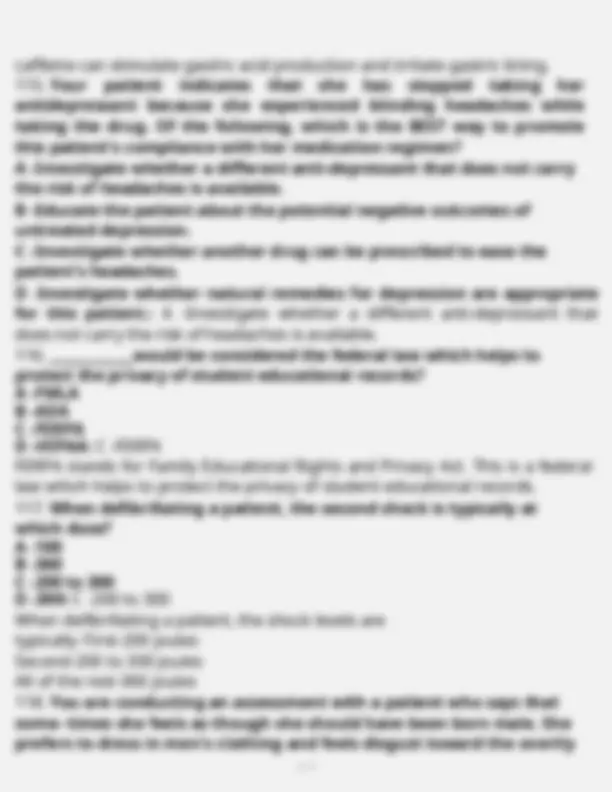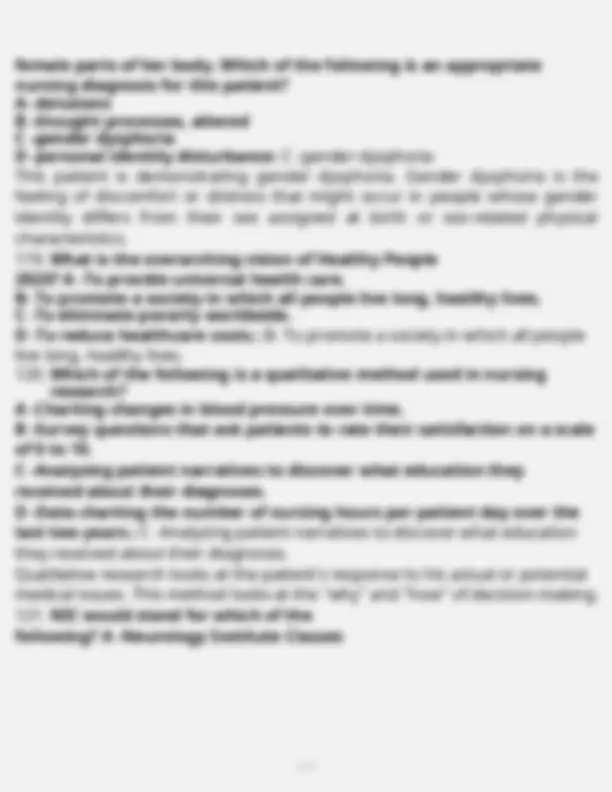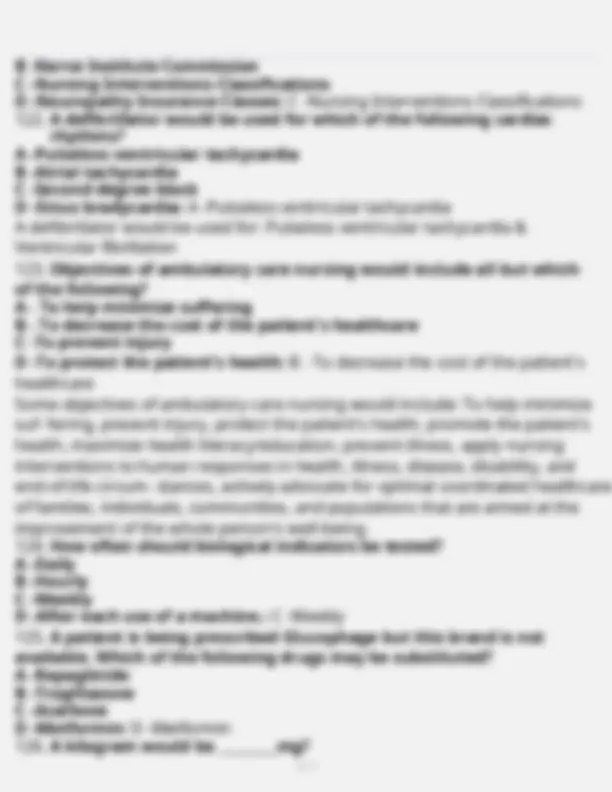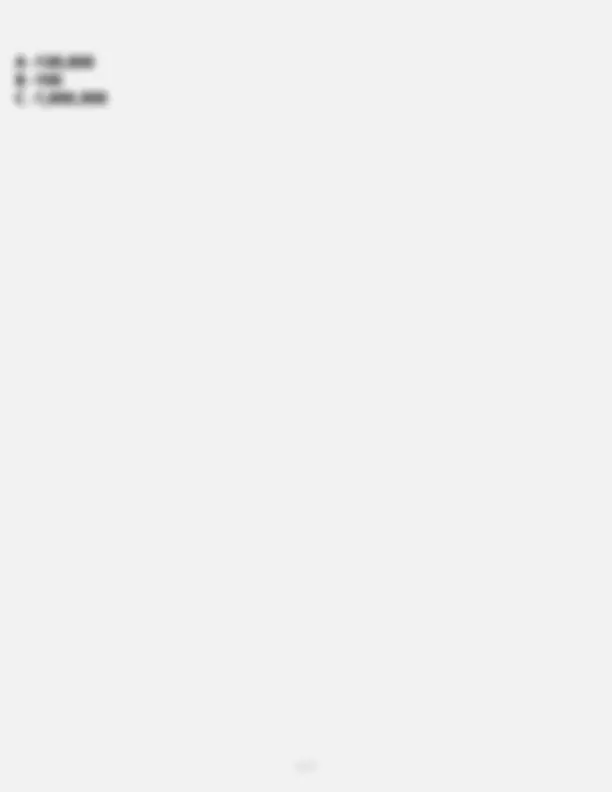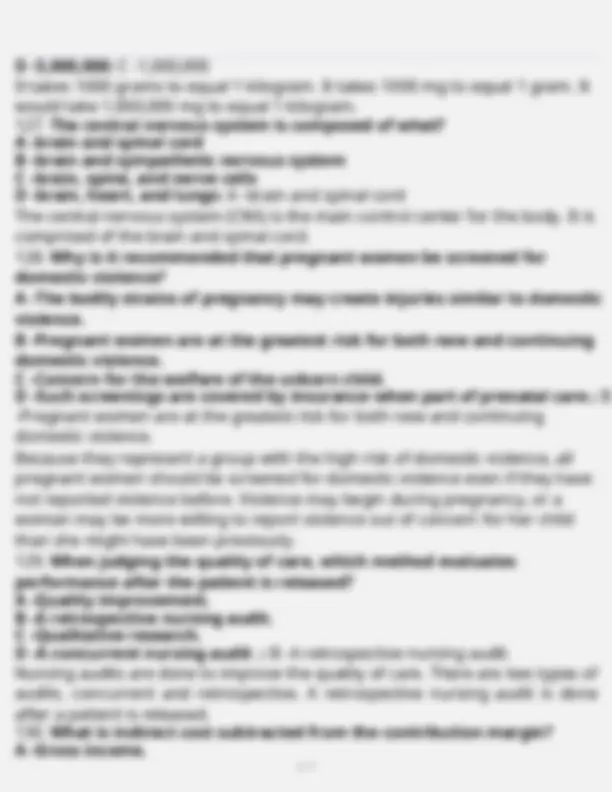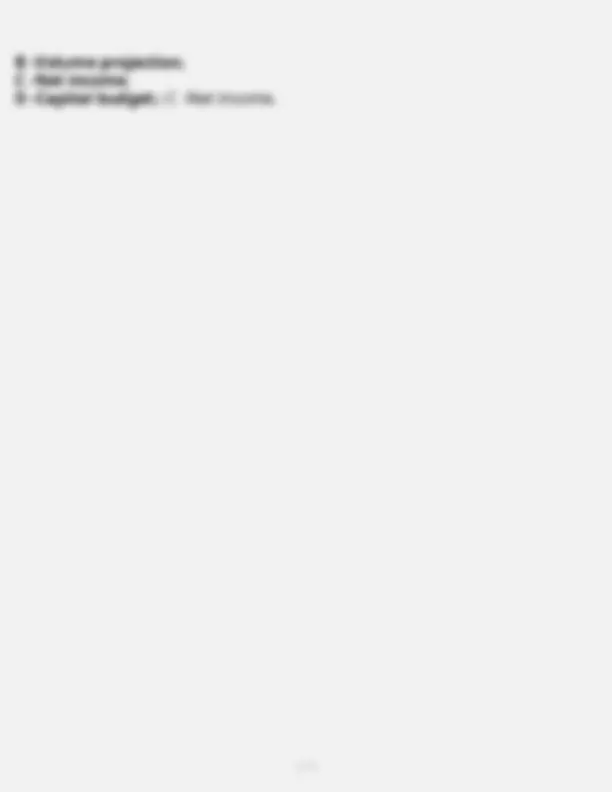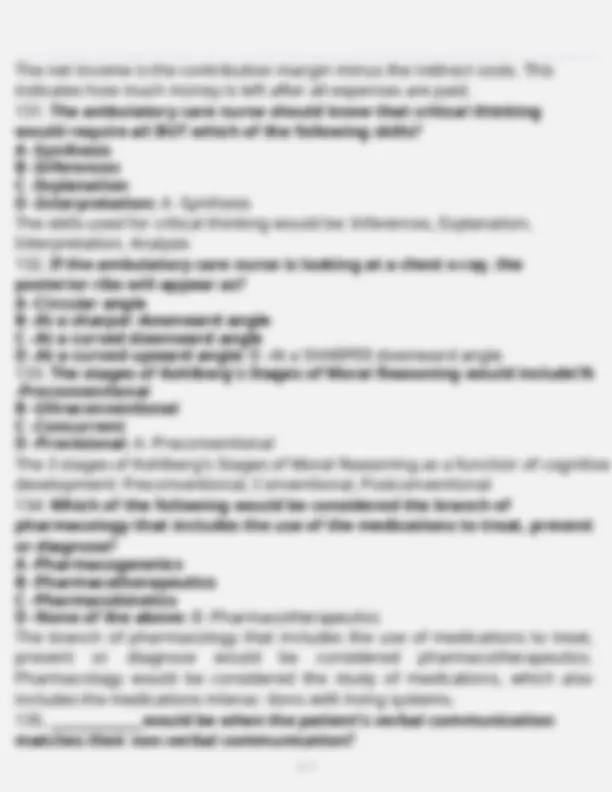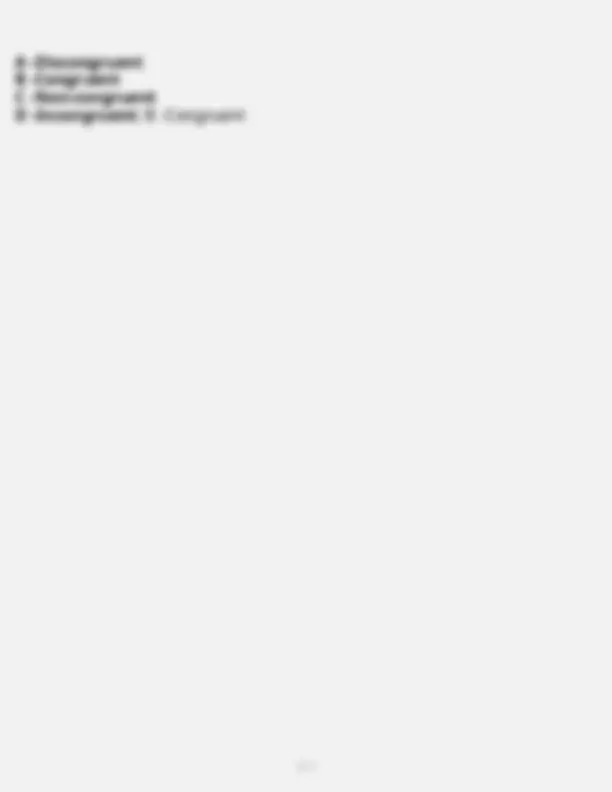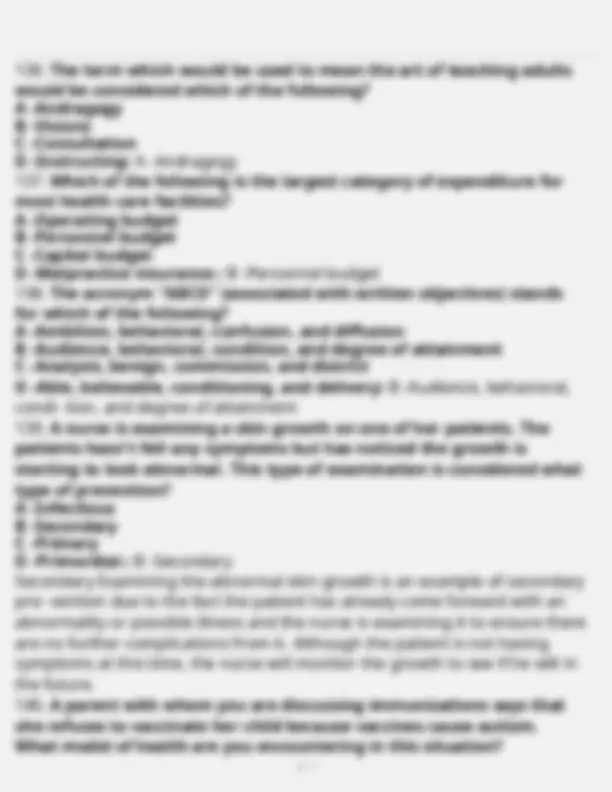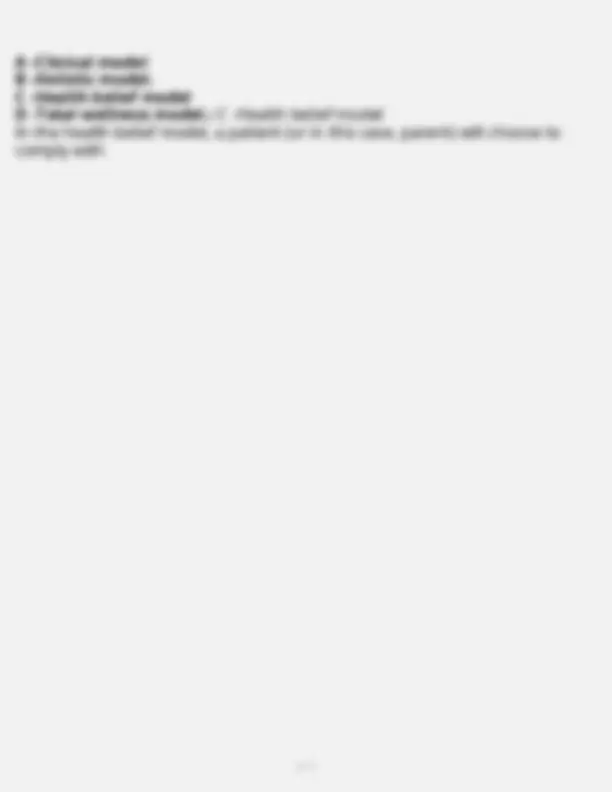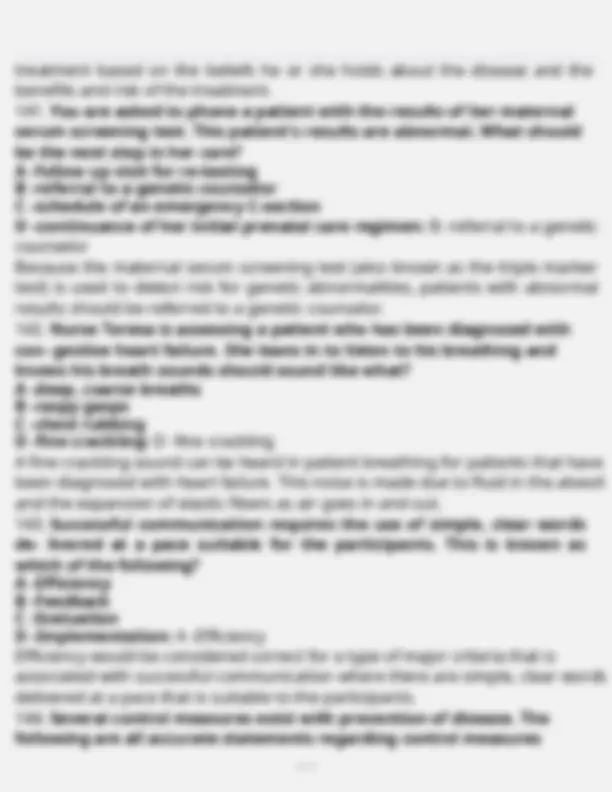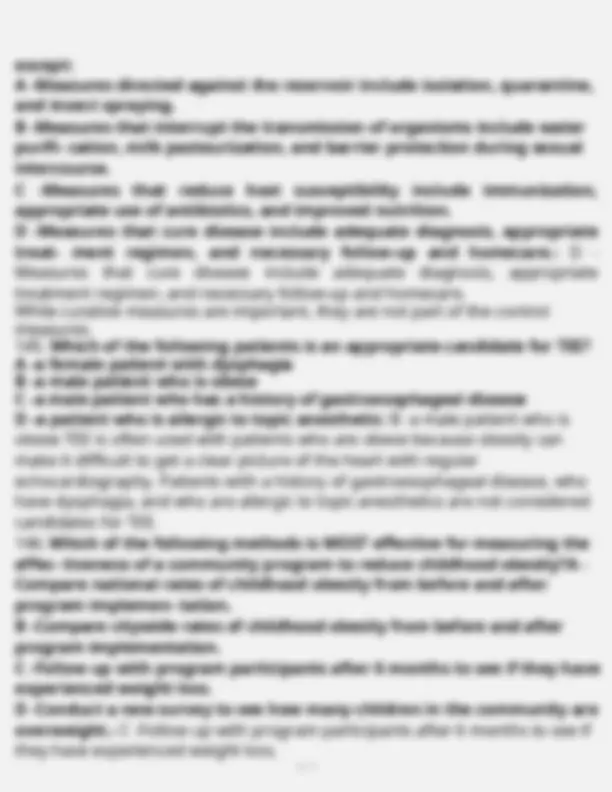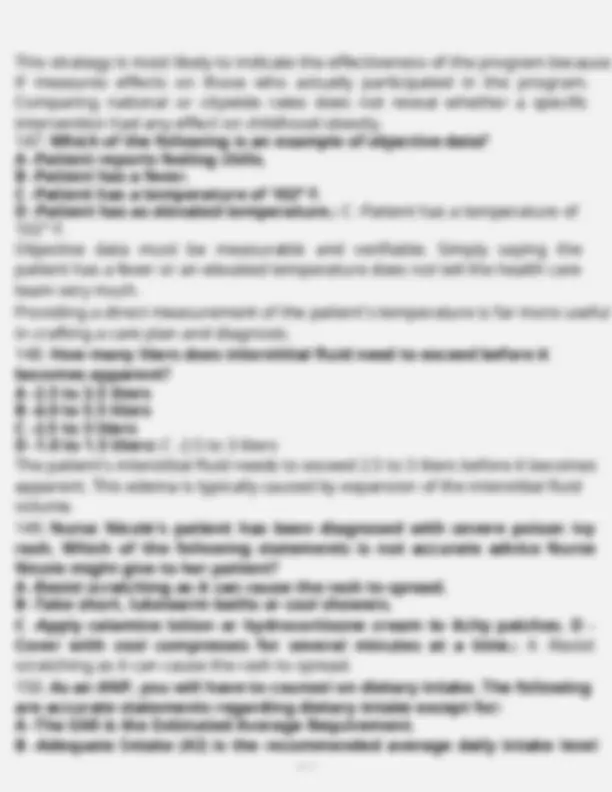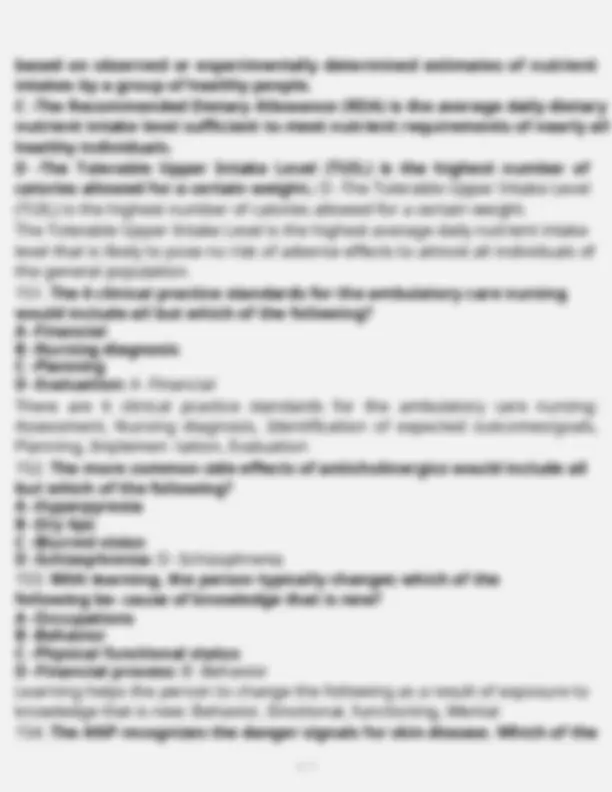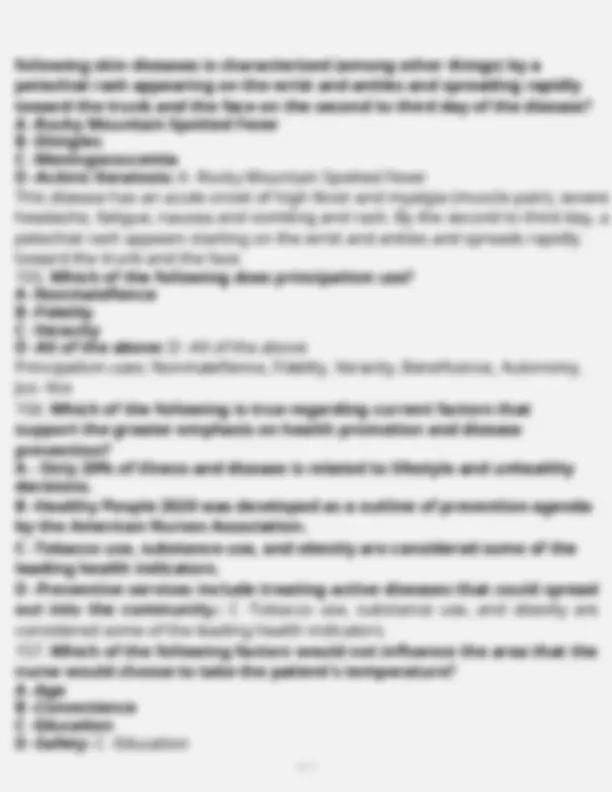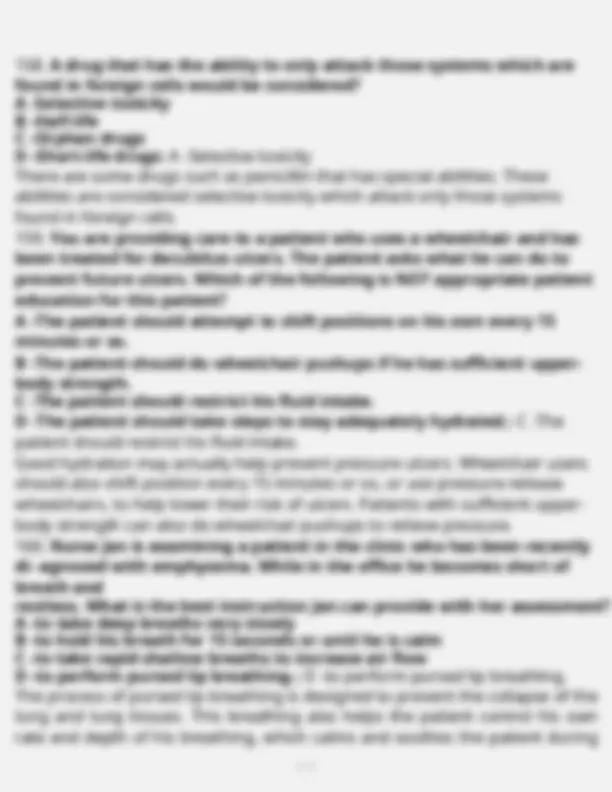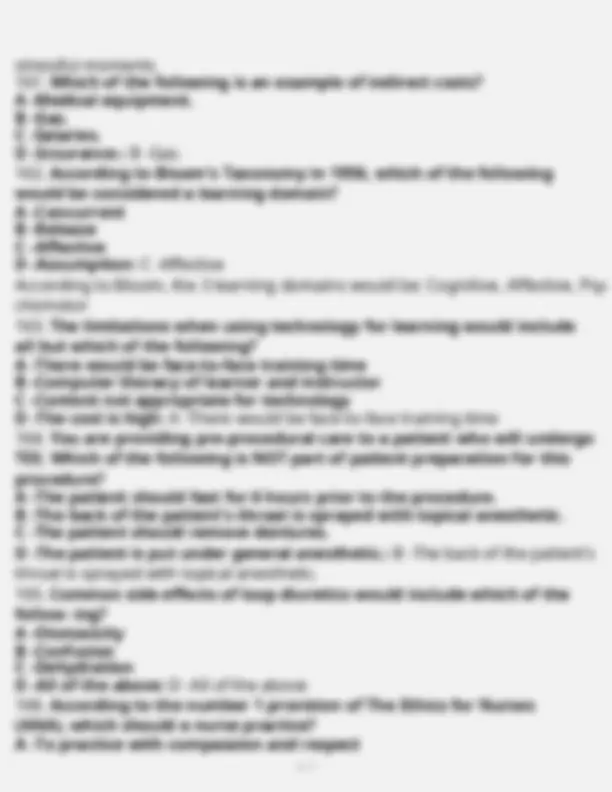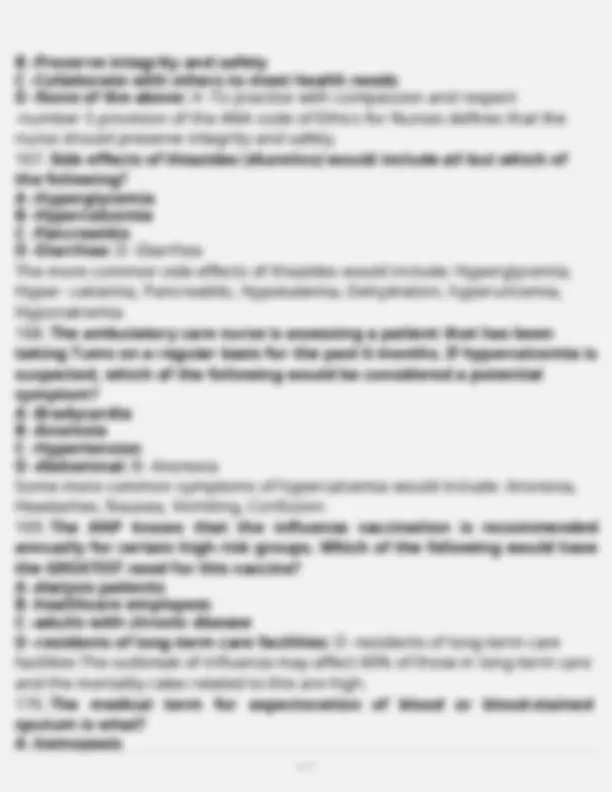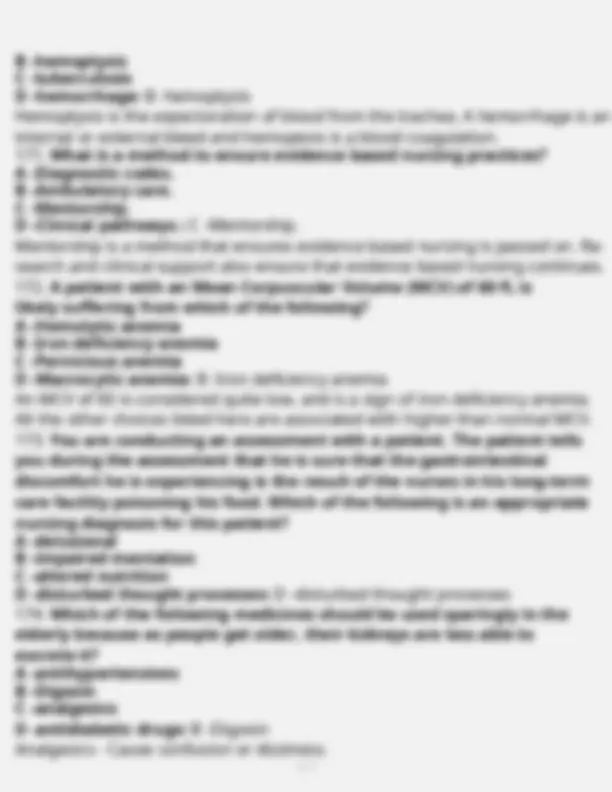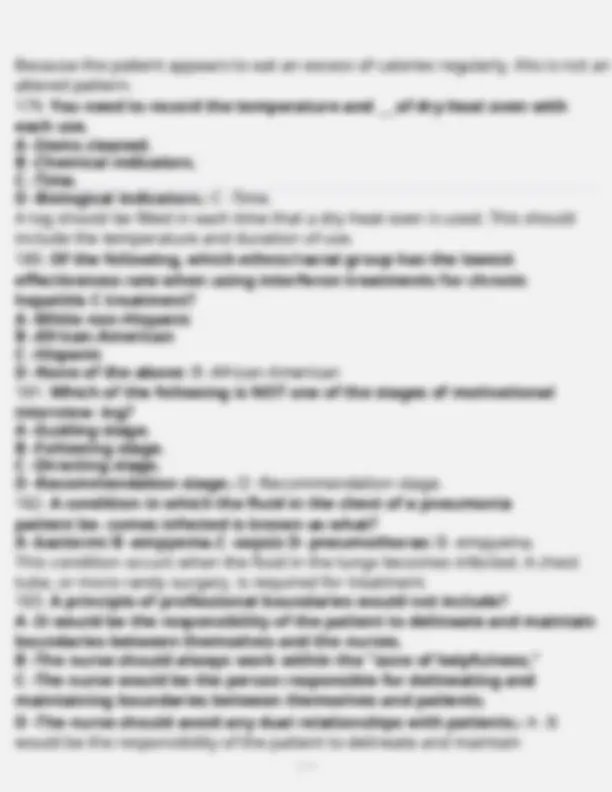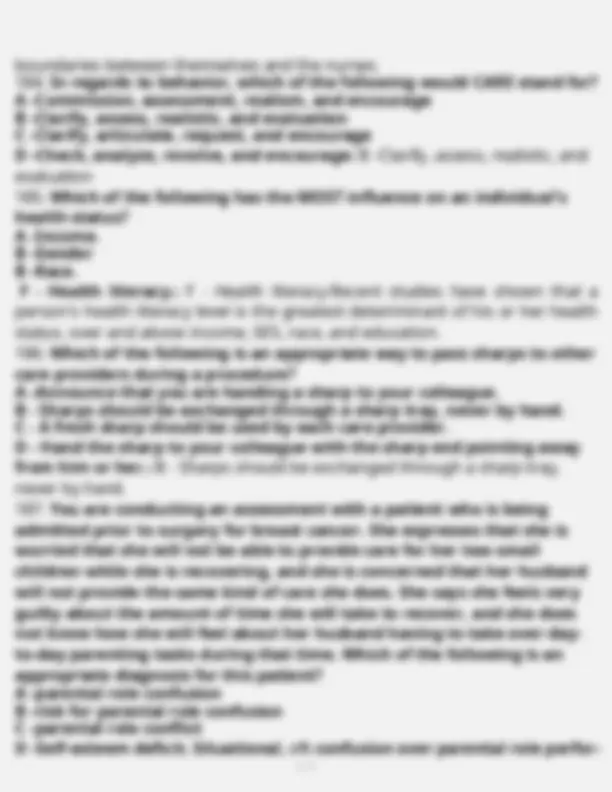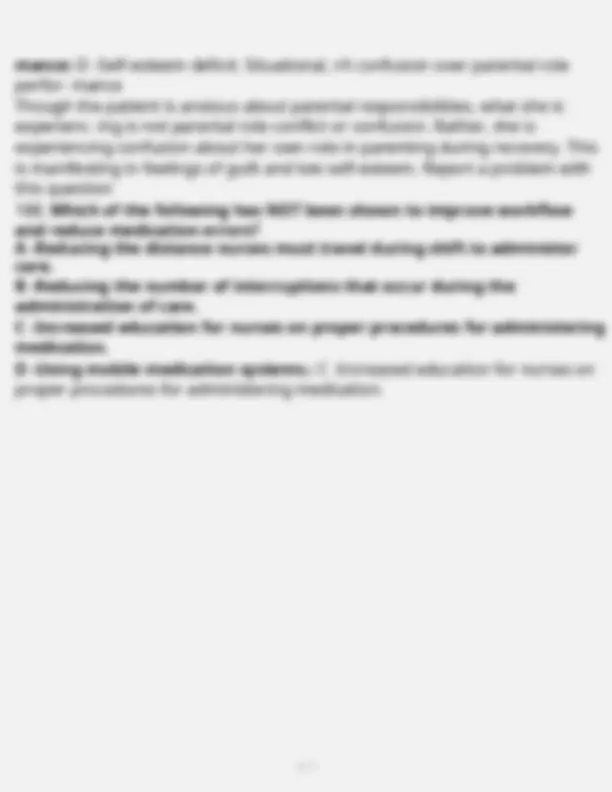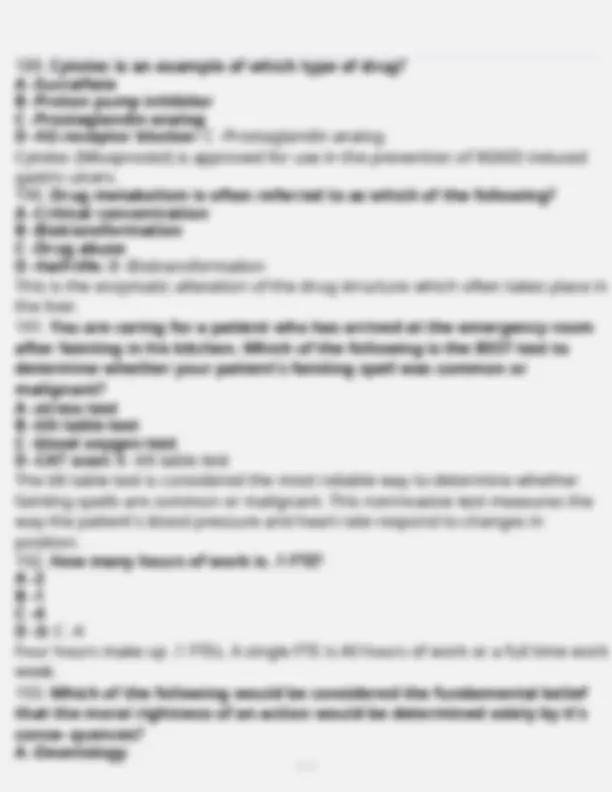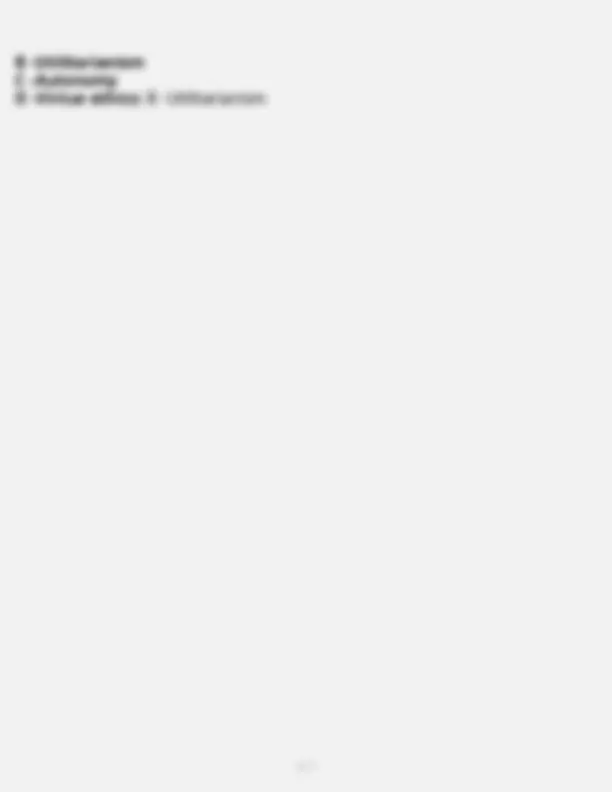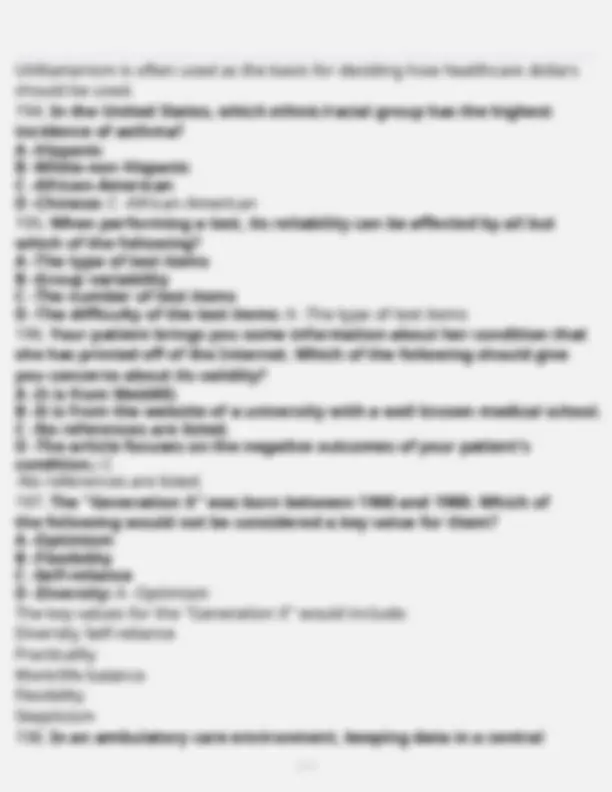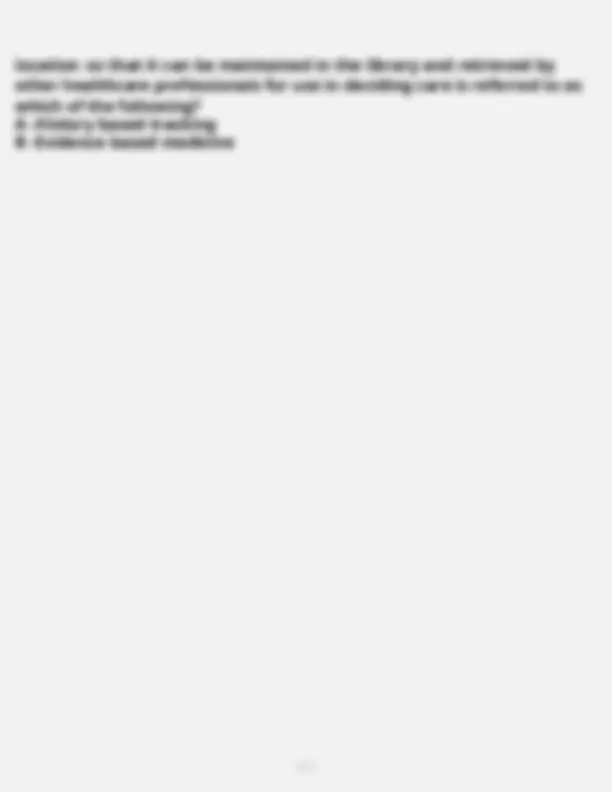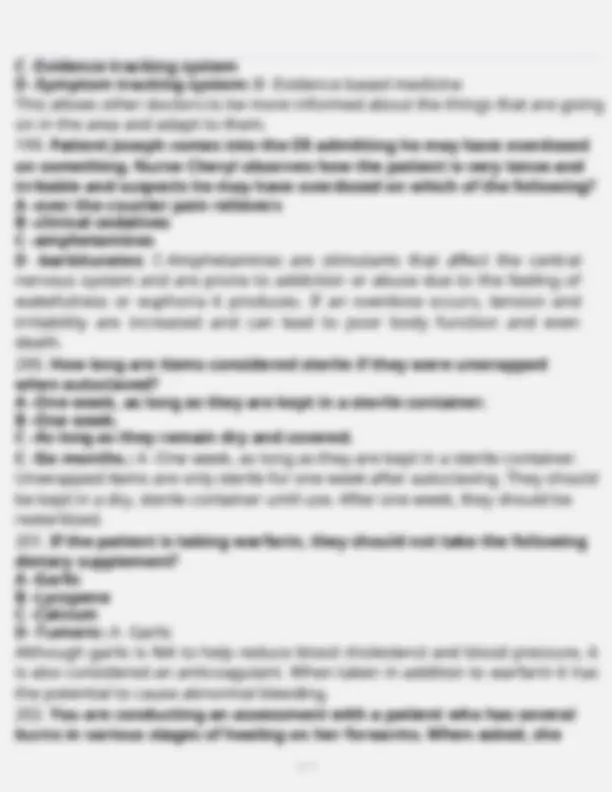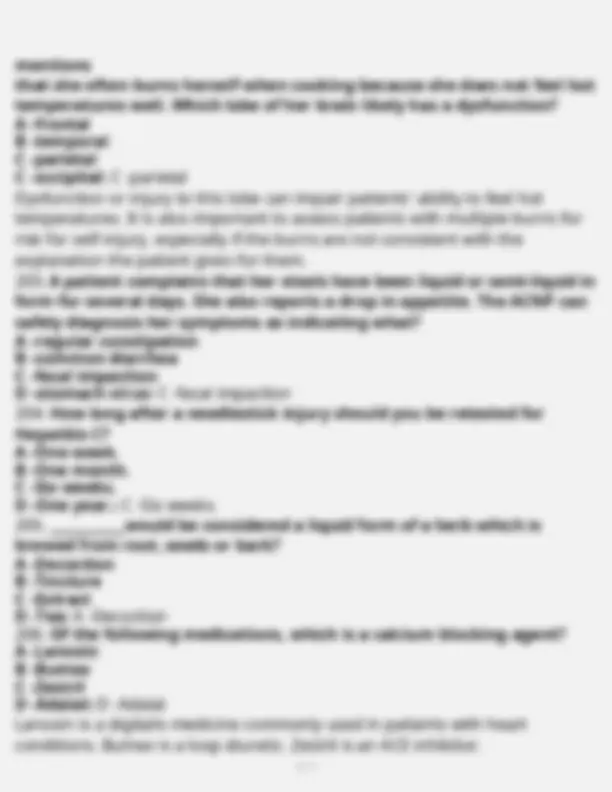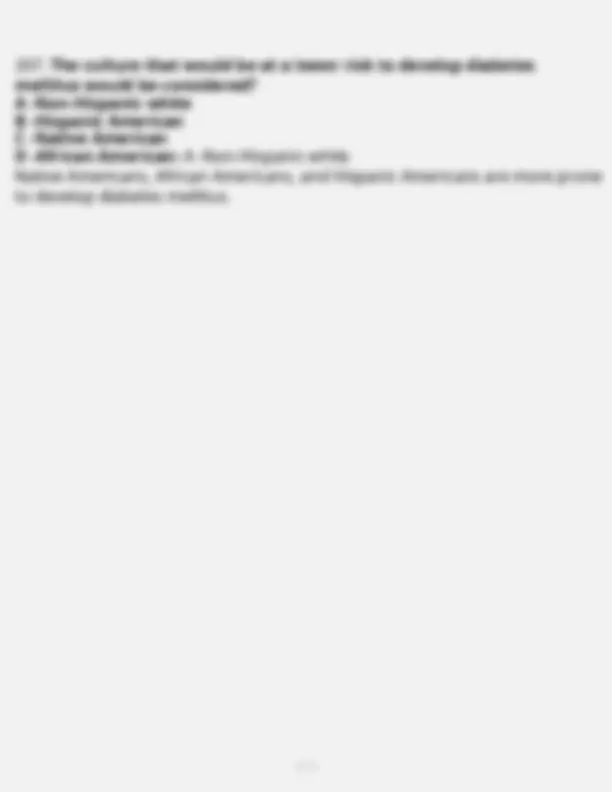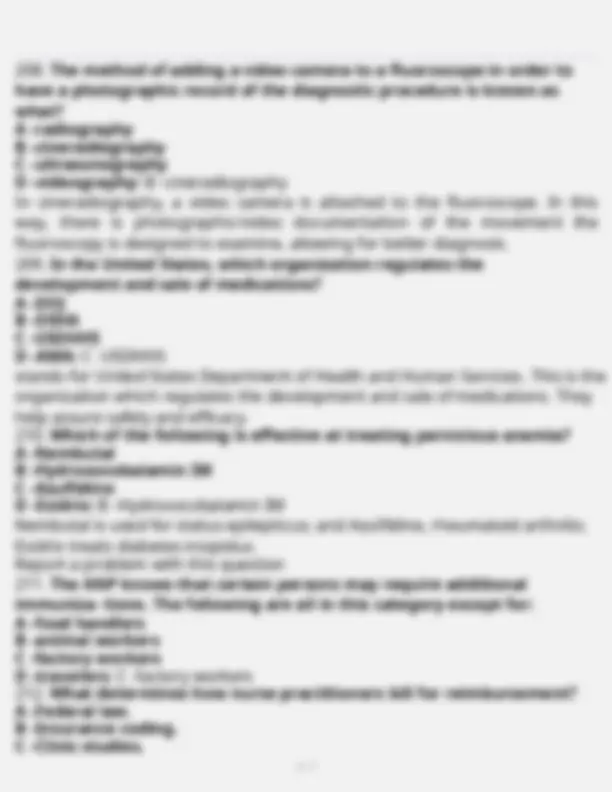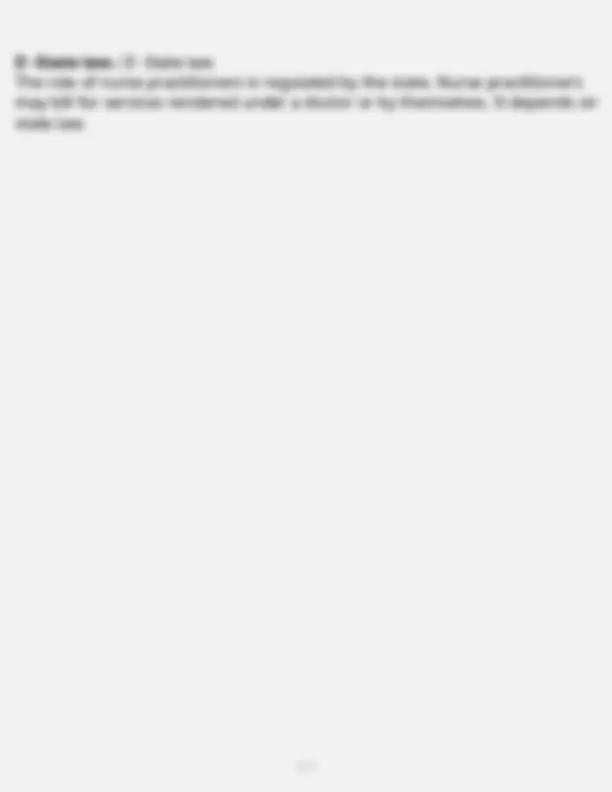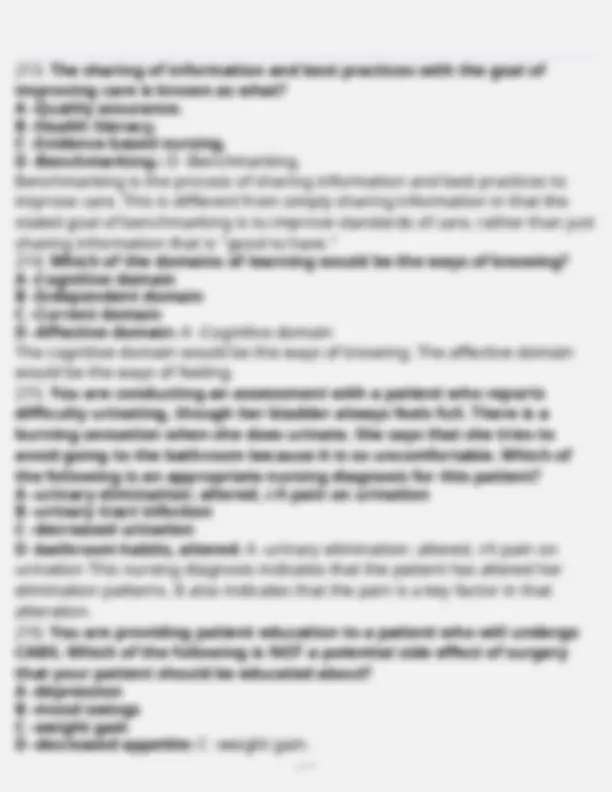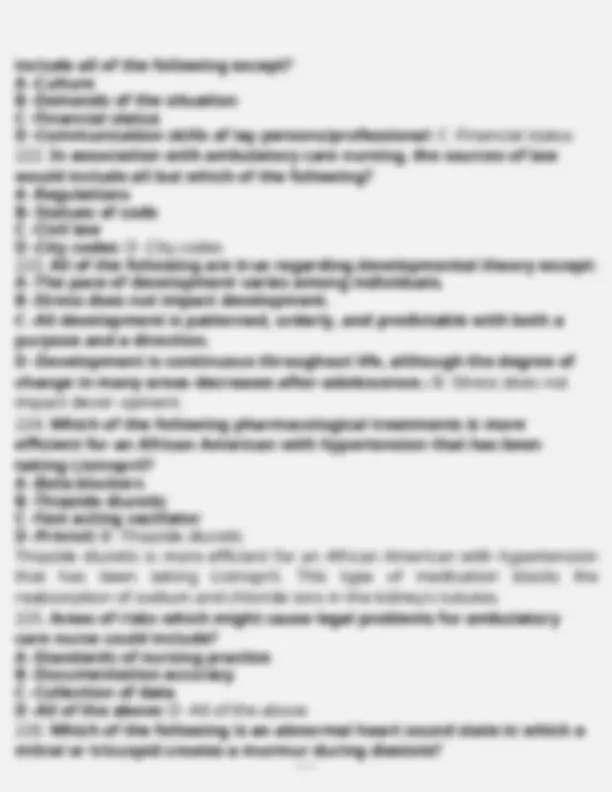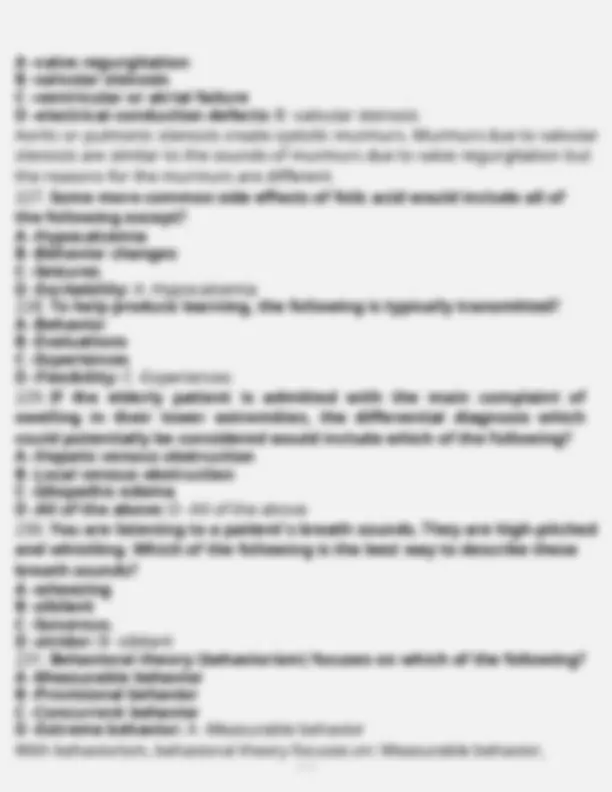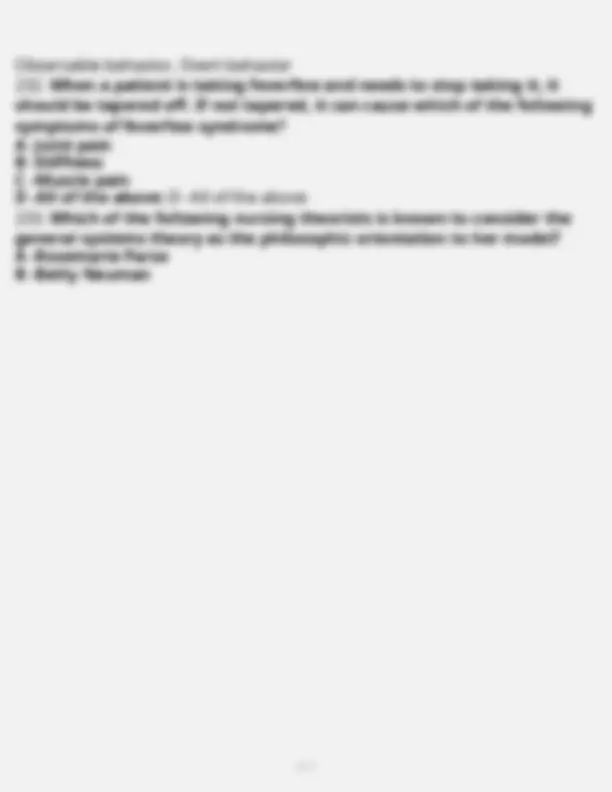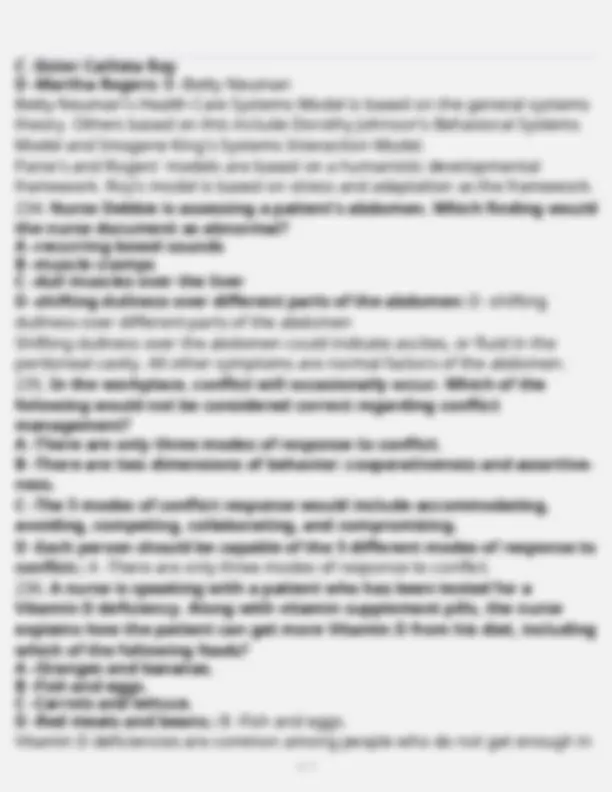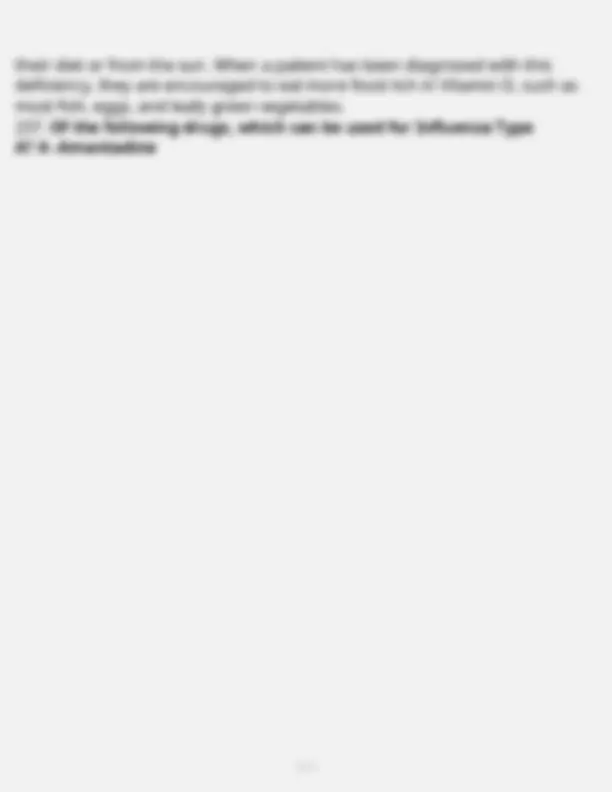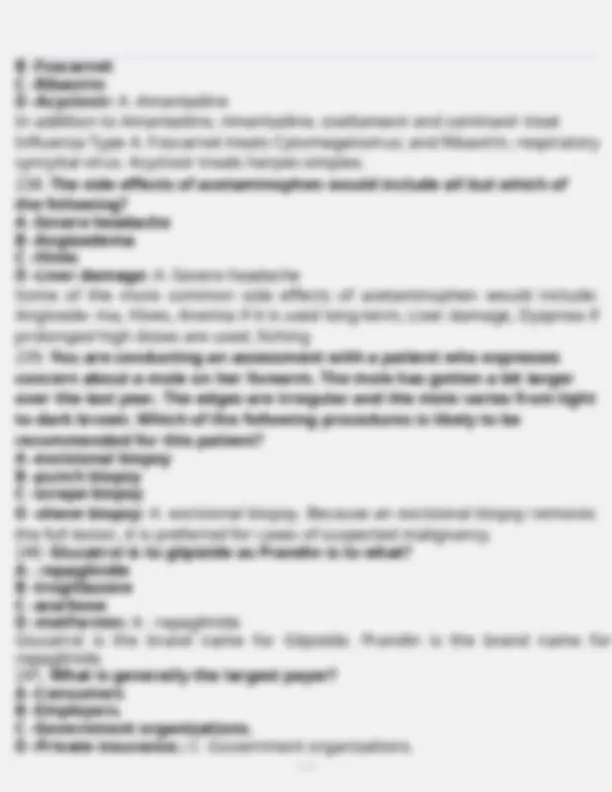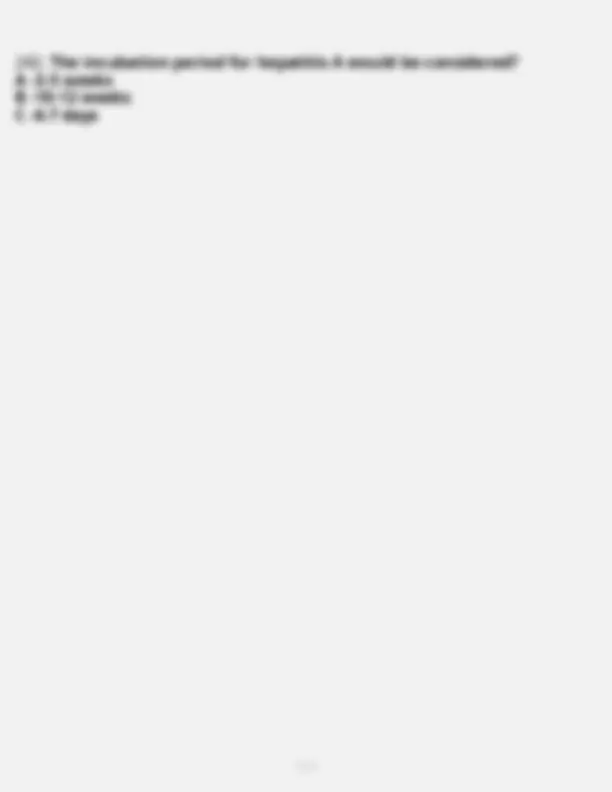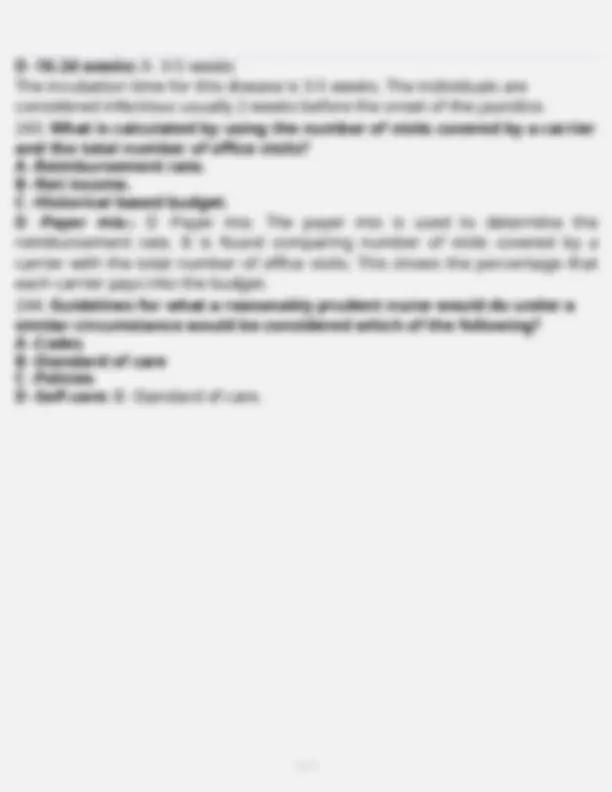Download Ambulatory Care Nursing Certification revision questions latest download /newest and more Exams Nursing in PDF only on Docsity!
Ambulatory Care Nursing Certification revision
questions latest download /newest
- How many medications does it typically take to be considered "polyphar- macy?" A -Three B -Ten C -Twenty-four D -Five or more: D -Five or more
- The ANP knows that it is her responsibility to report certain things to the proper authorities. Which of the following is NOT required to be reported? A - gunshot wound B - suspected child abuse C - drug abuse D - stab wounds: C - drug abuse Drug abuse is not required by law to be reported. Gunshot wounds, stab wounds, and child abuse (actual or suspected) are required to be reported to the proper authorities.
- Prior to undergoing an abdominal sonogram, the patient should do what? A - refrain from food and water for 12 hours B - empty his or her bladder C - drink a liter of water D - empty his or her bowels: C - drink a liter of water Prior to an abdominal sonogram, the patient is asked to drink water. In addition fasting for 8 to 12 hours prior to the procedure is often required.
- Which of the following is NOT part of a nursing diagnosis? A - statement of the patient's actual health status B -signs of illness C - medical diagnosis (such as stroke or pulmonary blockage) D - symptoms of illness: C - medical diagnosis Nursing diagnoses should never contain medical diagnoses. Rather, the
nursing diagnosis is a statement of the patient's actual health status, risks for condition developing, causative and related factors, and signs and symptoms.
- Primary care would be considered the cornerstone of ambulatory care with nurses practicing in which of the following areas of healthcare? A - Telehealth services B - Internal medicine C - Pediatrics D - All of the above: D - All of the above
- Which of the following would FDA stands for? A - Food and Drug Administration B - Food Depression Association C - Fixed Depression Administration D - None of the above: a - Food and Drug Administration This is an agency which regulates both the development and sale of drugs.
- Endoscopes are cleaned and. A - High level disinfected. B - Sterilized. C - Low level disinfected. D - Intermediate level disinfected.: A - High level disinfected. Endoscopes are critical items. Critical items are normally sterilized after being cleaned. Endoscopes cannot be sterilized and require high level disinfection.
- Which of the following is considered an independent nursing action? A - teaching a patient about the new diet she has been prescribed for manage- ment of her condition B - assisting the speech therapist by helping the patient practice speech exercises C - administering pain medication to the patient D - giving the patient a backrub: D - giving the patient a back rub Independent nursing actions are those which do not require a physician's order. Giving a backrub is one of these independent nursing actions. In the age of managed care, actions which arise from collaborative care plans are known as interdependent actions.
- Which of the following is a digitalis medicine? A -Lanoxin B - Bumex C - Zestril
A - primary B - secondary C - tertiary D - annual: A - primary Primary prevention, such as an immunization, aims to prevent health problems before they start. Secondary prevention promotes early detection and treatments of diseases. Tertiary prevention is designed to help a patient cope with a current problem or prevent relapse. "Annual" is not a type of prevention.
- For successful communication, the major criteria would include? A - Forcefulness B - Flexibility C - Evaluation D - Developmental: B - Flexibility The 4 major criteria for successful communication would include: Feedback, Appro- priateness, Efficiency, Flexibility
- A person's knowledge is sometimes measured by which of the following verbs? A -Recall B - List C - Remember D - All of the above: D - all of the above Some of the verbs which might be used to measure a person's knowledge could include: Recall, List, Remember, Identify, State, Define
- A key value in association with "Baby Boomers" would be considered which of the following? A - Sacrifice B - Duty C -Respect for authority D - Involvement: D - Involvement There are 3 key values that are associated with "Baby Boomers:" Involvement, Personal growth, Team
- You are assessing a patient prior to surgery and want to check for her sur- gical risk due to alcohol consumption. That patient tells you that her alcohol use varies and she does not seem willing to discuss how much she drinks. Which of the following is an appropriate strategy for
getting the information you need? A -Present the patient with graphic images of the internal organs of people who abuse alcohol. B -Shame the patient into telling you what you need to know. C - Refer the patient to a social worker at the hospital. D - Ask a family member, such as the patient's spouse, about the patient's alcohol use.: D - Ask a family member, such as the patient's spouse, about the patient's alcohol use.
- Which of the following is NOT a concern when developing health literacy education for patients? A - Literacy level. B - Cultural background. C - Language. D - Gender: D - Gender
- When learning in the affective domain, it would involve internalization or commitment to which of the following? A - Feelings B - Interests C - Cognitive D - Both A and B: D - Both A and B When a person is learning in the affective domain, it would involve internalization or commitment to: Feelings, Interests, Attitudes, Beliefs, Values
- Of the following, which would be considered the name for when it would reflect the chemical structure of a drug? A - Generic name B - Common name C - Trade name D - Chemical name: D - Chemical name
- An older patient presents with swelling in the lower extremities. Which of the following should be ordered to rule out heart failure? A - CBC B - Spirometry study C - Brain natriuretic peptide test D - Ketone balances: C - Brain natriuretic peptide test (BNP) The BNP measures levels of protein made by your heart will be higher than normal since it is produced by your blood vessels in your heart.
recent study, are middle class Caucasians.
- POCT and which of the following terms are often used interchangeably? A - Diagnosing B - Referrals C - Consultations D - Onsite testing: D - Onsite testing
- would be the feeling of distress, suffering, and/or discomfort that is considered a symptom of a condition? A - Temperature B - Pain C - Management D - Cultural: B - Pain Pain would be the feeling of distress, suffering, and/or discomfort that is considered a symptom of a condition. In 1968, McCafferty defined pain as "Pain is whatever the patient that is experiencing the pain says it is."
- Nurse Agnes has just finished assessing her pregnant patient who has been diagnosed with gestational diabetes in the second half of her pregnancy. What does the nurse need the patient to do to help dietary and insulin needs? A - increase her insulin doses B - increase calorie intake C - decrease her insulin doses D - decrease calorie intake: B - increase calorie intake When a pregnant woman increases her caloric intake in the latter half of her pregnancy, glucose will cross the placenta but the insulin will not. The fetus has a high demand for glucose and when that is paired with the patient's changing hormones, the result is an elevated blood glucose level.
- During which of the following situations is full barrier precautions likely to be required? A - Treating a patient with pneumonia. B - Treating a patient with chicken pox. C - Treating a patient who is suspected of having avian flu. D - Treating a patient with an open wound.: C - Treating a patient who is suspected of having avian flu. Treating a patient who is suspected of having avian flu CDC guidelines
recommend full barrier precautions for all known and suspected cases of avian flu, due to the high degree of transmission of the disease. Full barrier precautions are also used in treating patients with known or suspected cases of SARS and pandemic influenza, as well as hemorrhagic diseases
- would be considered the nurse's competency that results from training. A - Education B - Language C - Culture D - Proficiency: D - Proficiency
- The ambulatory care nurse's role would have all except which of the following role dimensions? A - Workload B - Risk management C - Benefits D - Leadership: C - Benefits Some of the role dimensions for the ambulatory care nurse would include: Workload, Risk management, Leadership, Staffing, Competency concerns, Workplace regula- tory compliance
- Which of the following is NOT a nonmedical expense? A - Linen. B - Uniform. C - Office supplies. D - Hypodermics.: D - Hypodermics.
- Of the following, which would not be a predisposing factor that might cause a patient to develop a tubercle bacillus infection? A - Cirrhosis B - Alcoholism C - Poor nutrition D - The health care workers that care for low-risk patients: D - The health care workers that care for low-risk patients
- The is supposed to protect the patients' rights, help them to participate in their healthcare decisions, and provide adequate healthcare education. A - Teacher B - Advocate C - Administrator
A - Respect B - Space C - Caring D - Openness: B - Space Some of the factors which could have the potential to promote communication would include: Respect, Caring, Openness, Disposition, Warmth/friendliness, Empathy, Honesty, Competence
- would be when a leader aligns themselves with others to help obtain information, ideas, advice, power, and influence? A - Consensus-building B - Negotiation C - Networking D - Development: C - Networking
- Details which should be focused on when choosing a glucometer would include all but which of the following? A - The type of lancing device B - Coding the machine C - The look of the meter D - The color of the meter: D - The color of the meter There are 7 details which should be focused on when choosing a glucometer: The type of the lancing device, Coding of the machine, The look/display of the meter, The memory capacity of the meter, The sample size which will be needed, How long does it take for a result, Are there any additional features
- Which of the following emphasizes preventive services like notification of contacts for patients with infectious diseases, screenings, and immunization at the local level? A - Local schools B - Local pharmacies C - Public Health departments D - State disease control: C - Public Health departments Public Health departments emphasize preventive services like notification of con- tacts for patients with infectious diseases, screenings, and immunization at the local level. The public health department plays an integral Lowell Community Health.
- What is the MOST effective form of research a nurse can do before estab- lishing a diabetes prevention course for patients?
A - Making a list of the local endocrinologists that are currently treating diabetic patients. B - Estimating what age groups would attend the course. C - Documenting what causes diabetes and why. D - Finding diabetic-friendly recipes to share with the class.: C - Documenting what causes diabetes and why. When a nurse is planning an event to raise awareness of preventing a disease, the first types of research that should be done is what causes the disease and why. Once this information is documented, the nurse can build her lesson around methods of prevention, warnings signs, etc.
- One of the more important steps for the ambulatory care nurse during diagnosis would be which of the following? A - Documentation of information B - CT equipment C - State disease control D - X-ray equipment: A - Documentation of information
- Which of the following abnormal heart sounds is a result of the blood flowing past the normally closed valve? A - valve regurgitation B - valvular stenosis C - ventricular or atrial failure D - electrical conduction defects: A - valve regurgitation The sound of valvular regurgitation is known as a murmur. Murmurs can have a blowing or swishing sound and are categorized in a degree of I to VI. Grade I murmurs are very soft, while grade VI murmurs are extremely loud and can be heard with the stethoscope one inch away from the chest wall.
- Each person has how many intelligences (according to Howard Garner's multiple intelligence theory)? A - 8 B - 12 C - 3 D - 38: A - 8 According to the Howard Garner's multiple intelligence theory, each individual has 8 intelligences. These intelligences form the basis for the individuals learning through- out their life.
- What type of budget should be done for a new practice? A - Zero based. B - Hyperlink Process. C - Historical based budget. D - Capital budget.: A - Zero based. Established practices used historical based budgets that are based off previous years. Zero based budgets are used with new practices and requires expenses to be tracked and managed carefully.
- You are performing an assessment with a patient. On auscultation of heart sounds, you hear a scratching, creaking sound. Which of the following conditions might this heart sound indicate? A - congestive heart failure B - benign heart murmur C - pericarditis D - pneumothorax: C - pericarditis. Patients with pericarditis will often have a scratching or creaking sound. This is known as a pericardial friction rub and results from inflammation of the pericardium.
- The 5 M's of categorizing information (according to the Failure Mode and Effect Analysis) would include all but which of the following? A - Materials B - Maneuvering C - Methods D - Machines: B = Maneuvering The 5 M's of categorizing information (according to the Failure Mode and Effect Analysis) would include: Machines, Management, Manpower, Materials, Methods
- Where is the submental lymph node located? A - in the hollow of the clavicle B - right below the chin C - junction between back of head and neck D - behind the ears: B - right below the chin The supraclavicular lymph node is in the hollow of the clavicle. The suboccipital lymph node is located in the junction between the back of the head and neck. The postauricular lymph node is behind the ears.
- The objective for nursing practice in each state would be considered all of the following except? A - Will define the practice of professional nursing. B - Provide the disciplinary action of licenses for certain causes. C - Will define the length of the shifts that the nurse may work. D - Would set the minimal educational qualifications and other requirements for licensure.: C - Will define the length of the shifts that the nurse may work. The 4 objectives for the nursing practice in each state: Will determine the legal titles and abbreviations nurses may use. Would set the minimal educational qualifications and other requirements for licensure. Provide the disciplinary action of licenses for certain causes. Will define the practice of professional nursing.
- In negotiations the development of trust would include which of the follow- ing? A - Do not prepare beforehand B - Do not share notes C - Develop plans D - None of the above: C - Develop plans The development of trust in negotiations would include: Maintain and share notes. Observe for behavior reflecting dishonesty. Research and prepare beforehand. Develop plans. Demonstrate respect
- Which of the following is NOT one of the key questions of the Ask Me 3 Model? A - What is my main problem? B - What is the mortality rate for my problem? C - What do I need to do? D - Why is it important for me to do this?: B - What is the mortality rate for my problem? The Ask Me 3 model provides three questions that patients should be able to answer at the end of a health care visit. The mortality rate of a given health problem may be a concern, but this model is more centered on ensuring patient understanding of the condition and the necessary next steps.
- Disinfectant solution needs to be marked with the name,. A - Date prepared and the date expired.
B - Putting nurses on either permanent day or permanent night shifts. C - Keeping schedules as regular as possible. D - Encouraging employees to avoid caffeine, alcohol, and other substances that might interfere with sleep.: B - Putting nurses on either permanent day or permanent night shifts. Shiftwork carries numerous risks, including sleep deprivation and resulting health issues such as immune system depression and digestive problems. Changing shifts often carries problems, but keeping employees on permanent night shifts also carries risks including loss of family time, health problems resulting from difficulties sleeping during the day, sleep deprivation, and emotional problems.
- Tips for the ambulatory care nurse in association with communication would not include? A- Use open ended questions B - Don't gather feedback from staff members C - Conduct communication at the proper time and place D - Use fewer words: B - Don't gather feedback from staff members Communication tips would include: Use open ended questions. Gather feedback from staff members. Conduct communication at the proper time and place. Use fewer words. Watch language used, avoid using technical terms and acronym which might not be understood by all. Respect the viewpoints and opinions of other's. Use body language to show interest. Use communication to build "USA" - understanding, support, and acceptance
- At what point in the autoclaving process are wrapped items considered sterile? A - As soon as they reach the recommended temperature. B - Immediately on removal from the autoclave, even if wrapping is still wet. C - As soon as the wrapping is dry. D - As soon as they reach room temperature after removal from the autoclave and all wrappings are dry.: D - As soon as they reach room temperature after removal from the autoclave and all wrappings are dry. It may take several hours for items to be fully dry and cool to room temperature after removing them from the autoclave. Wet packs must at all times be considered non-sterile, even if they have cooled to room
temperature.
- In a clinical workflow chart, what is the link that moves the workflow forward between processes? A - Dynamic connector. B - Hyperlink Process. C - On-page connector. D - Off-page connector.: B - Hyperlink Process. The hyperlink process is also called the hot link. It moves the workflow forward between processes.
- Which of the following is meant to standardize the patient care practices? A - OSHA regulations B - Respiratory Care protocols C - MSDS sheets D - USGS protocols: B - Respiratory Care protocols
- would be when a nurse is talking with a patient and their verbal communication doesn't match their non-verbal communication? A - Incongruent B - Congruent C - Discongruent D - Non-congruent: A - Incongruent
- Which of the following classifications of medications contain "thy?" A - Sulfonamides B - Glucocorticoids and corticosteroids C - Thyroid hormones D - Nitrates: C - Thyroid hormones Thyroid hormones contain "thy. "Glucocorticoids and costicosteroids end with "sone." Nitrates contain "nitr." Sulfonamides include "sulf."
- Of the following, which is the greatest risk factor for childhood obesity? A - Lack of cognitive stimulation. B - Poverty. C - Parental divorce. D - Parental Education.: A - Lack of cognitive stimulation. While all the choices listed are risk factors, lack of cognitive stimulation is
A - 40 mg/dL B - 15 mg/dL C - 55 mg/dL D - 100 mg/dL: B - 15 mg/dL The normal range for BUN:Cr is 10 - 20 mg/dL. Ratios above 20 may indicate some kidney injury.
- Screening for cancer in the geriatric population includes all of the following recommendations except: A - prostate cancer B - cervical cancer C - skin cancer D - colon cancer: B - cervical cancer Cervical cancer is not likely in the elderly female. The geriatric population should be screened for heart disease, hearing, vision, and dental problems, hyperlipidemia, hypertension, menopause, osteoporosis, hypothyroidism, and dementia. Cancer screenings include breast, colon, prostate, and skin.
- A patient is speaking with a telephone nurse and explains that she has had increased acid reflux from a recently diagnosed ulcer. The nurse's first question is to ask if the patient has had what kind of food lately? A - Dairy products. B - Acidic fruits such as oranges or lemons. C - Beans or lentils. D - Alcoholic or caffeinated beverages.: D - Alcoholic or caffeinated beverages. The nurse should explain to the patient beverages with alcohol or caffeine can stimulate gastric acid production and irritate gastric lining. The nurse should advise the patient to avoid these type of foods and for the patient to see their physician if symptoms persist.
- would be considered the federal law which helps to protect the privacy of student educational records? A - FMLA B - ADA C - FERPA D - HIPAA: C - FERPA FERPA stands for Family Educational Rights and Privacy Act. This is a federal law which helps to protect the privacy of student educational records.
- When defibrillating a patient, the second shock is typically at which dose? A - 100 B - 360 C - 200 to 300 D - 300: C - 200 to 300 When defibrillating a patient, the shock levels are typically:First-200 joules, Sec- ond-200 to 300 joules, All of the rest-360 joules
- In the clinic, which step of the nursing process does Nurse Betty use to determine if the patient understands the health information he was just presented? A - implementation B - evaluation C - assessment D - goal planning: B - evaluation The evaluation step of the nursing process includes the nurse observing the patient and asking questions to get a better idea of the person as a whole and to ensure he is learning the health information needed. This also gives the patient a chance to ask questions and clear up any misunderstandings.
- A hospitalized patient is diagnosed with pressure ulcers. What is one type of independent nursing intervention that can be used to help the patient? A - Apply a drying agent to reduce moisture at the site. B - Change the patient's positions to minimize pressure on the ulcers. C - Order surgical removal of the necrotic tissue. D - Soak the areas in Epsom salt.: B - Change the patient's positions to minimize pressure on the ulcers. Changing a patient's position reduces stress and pressure to the ulcer site and promotes healing. Applying a drying agent would not be effective since wounds need moisture to heal, and soaking would not relieve pressure and could spread infection. Surgical removal of the tissue would need to be prescribed and performed by a physician.
- The nurse is educating an adult patient regarding medications for asthma. Which order would be the most appropriate for administration? A - Albuterol, Flovent, Tobramycin B - Flovent, Intal, Tobramycin

